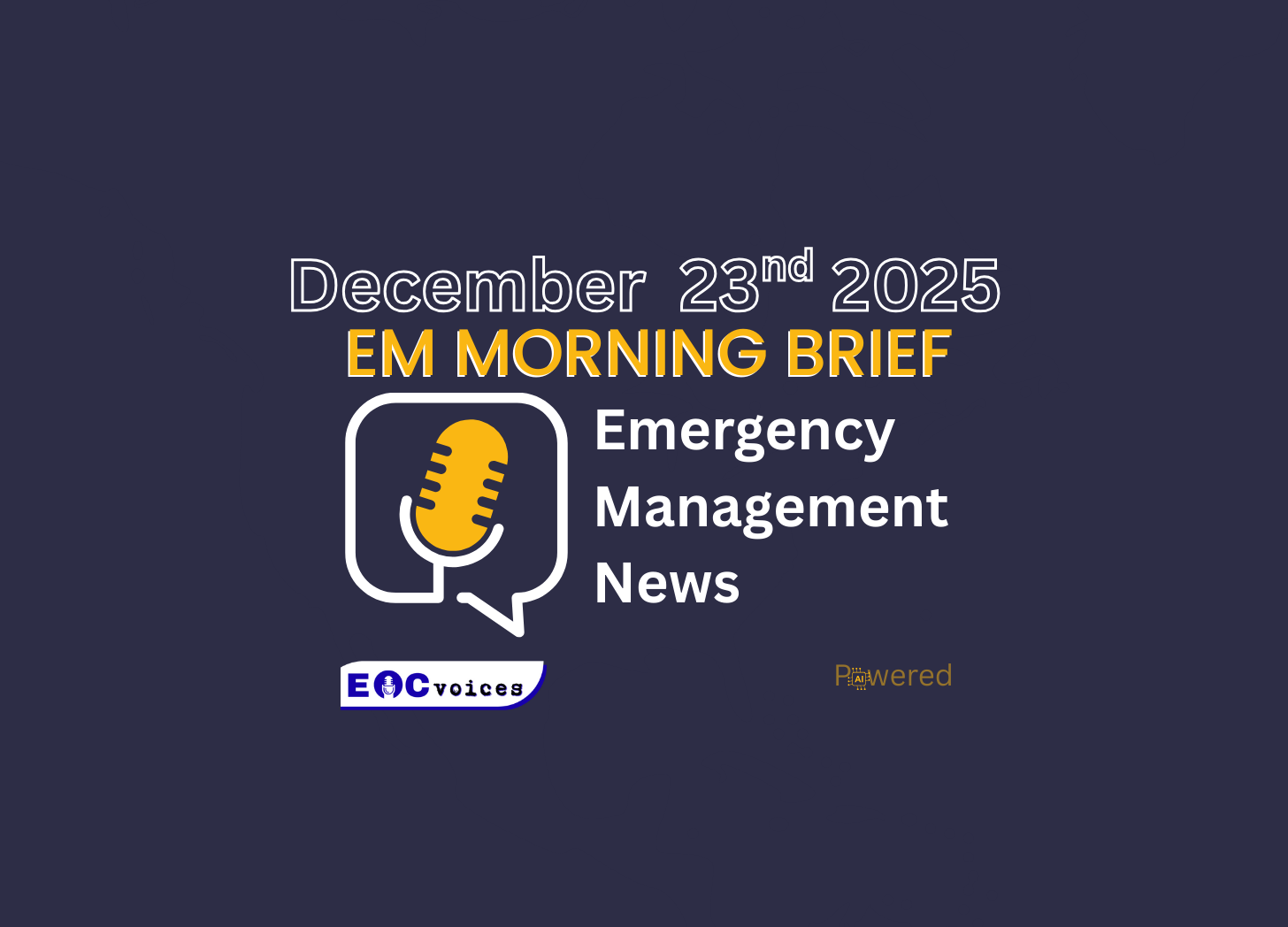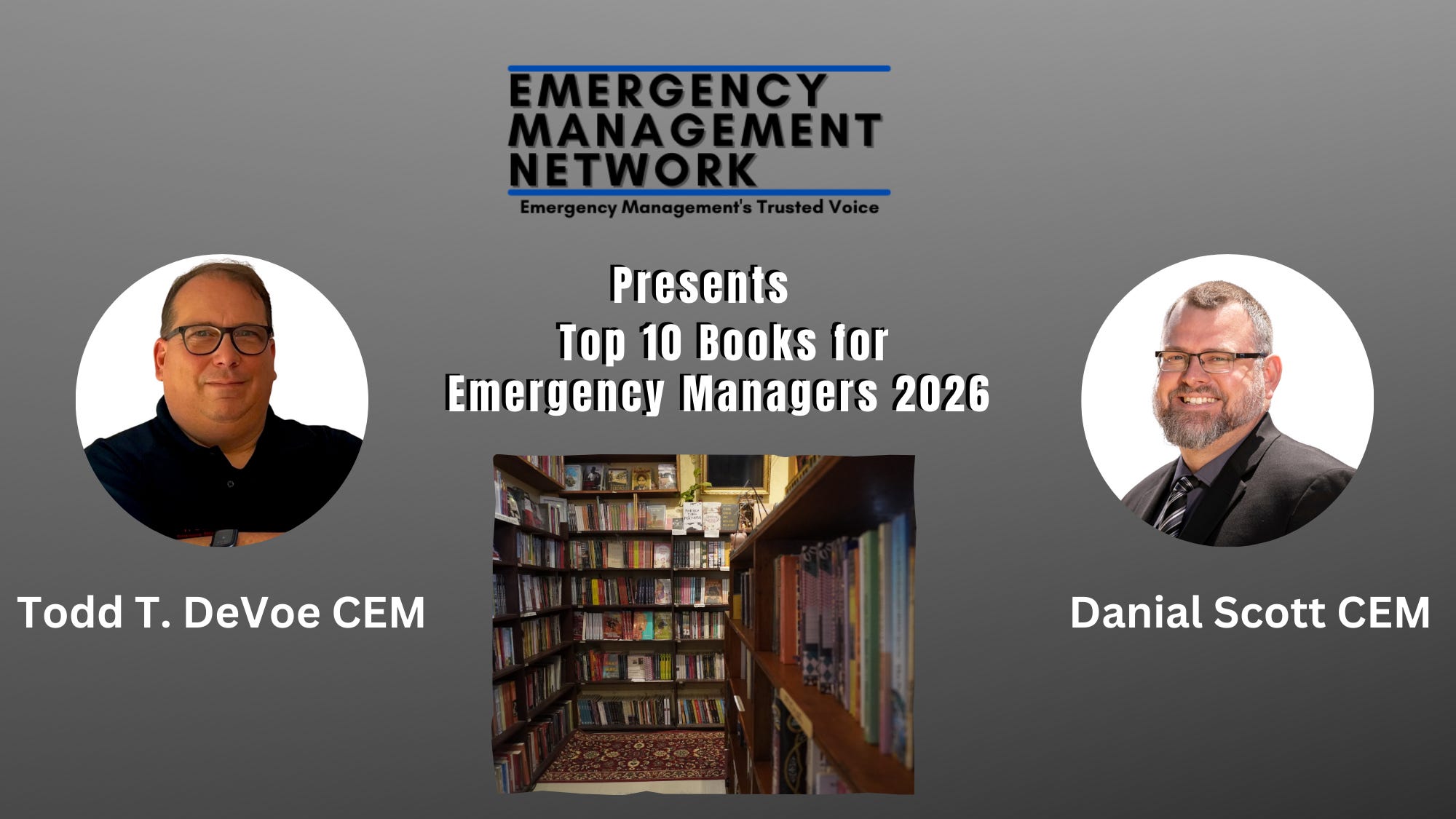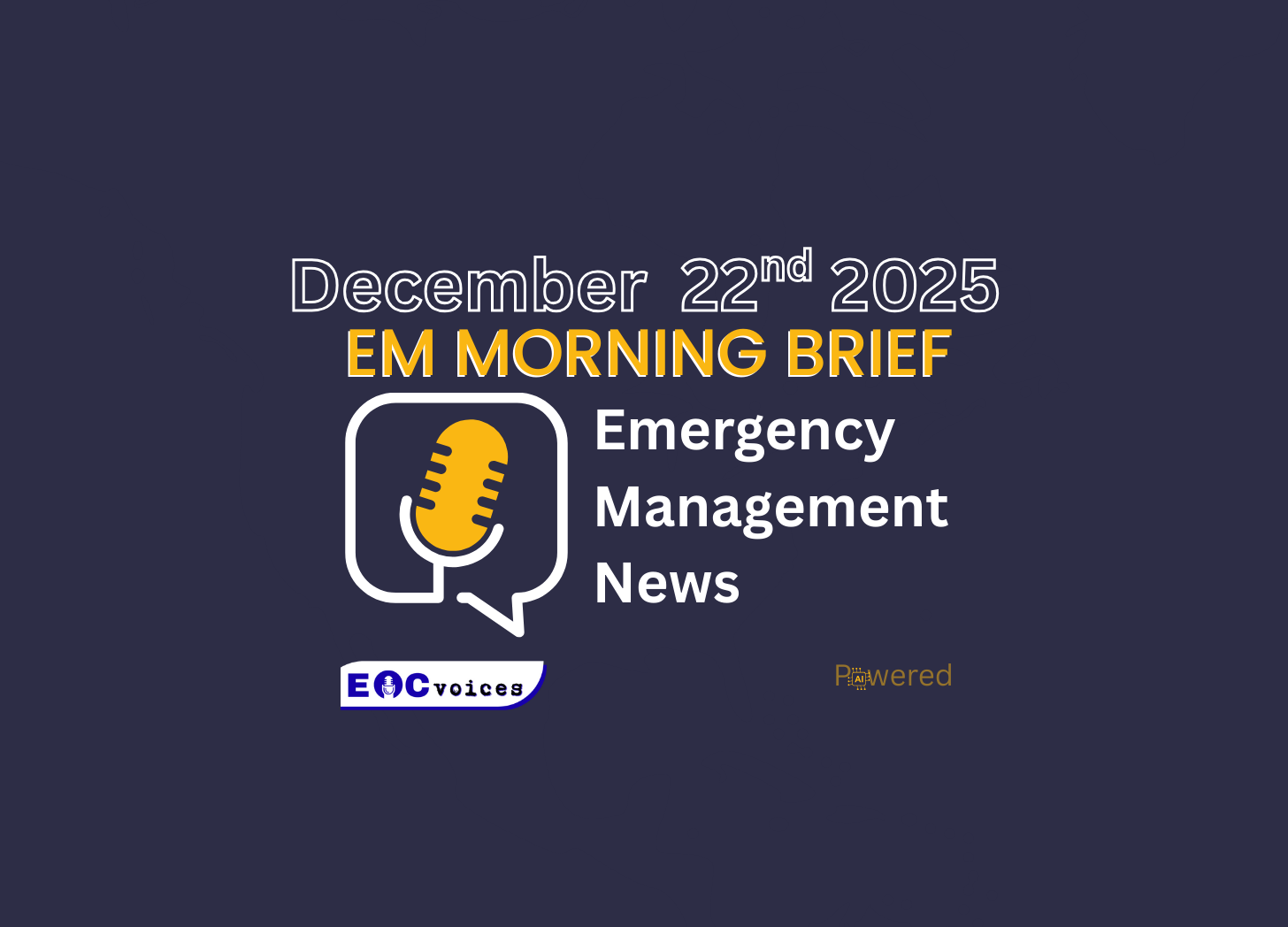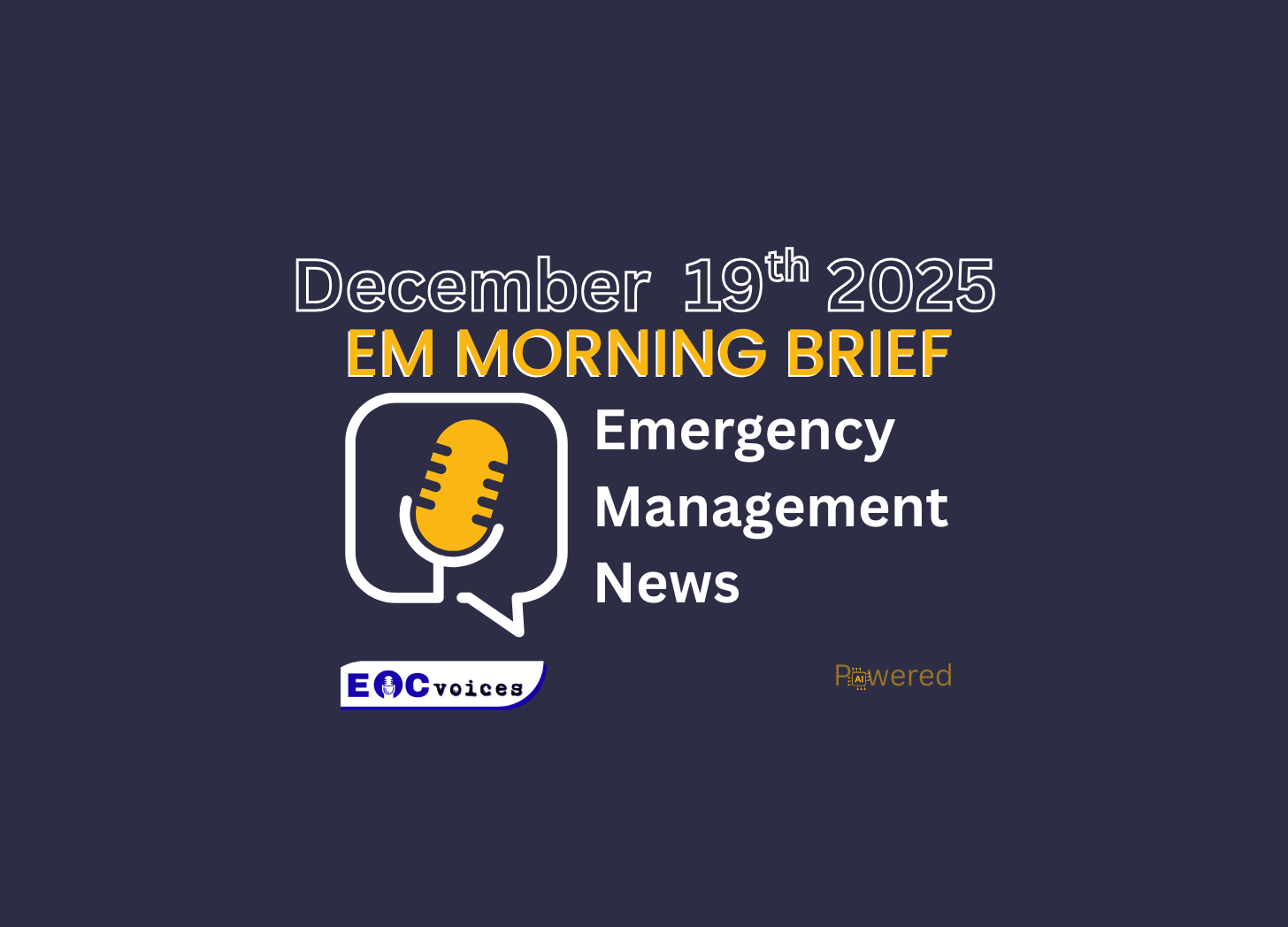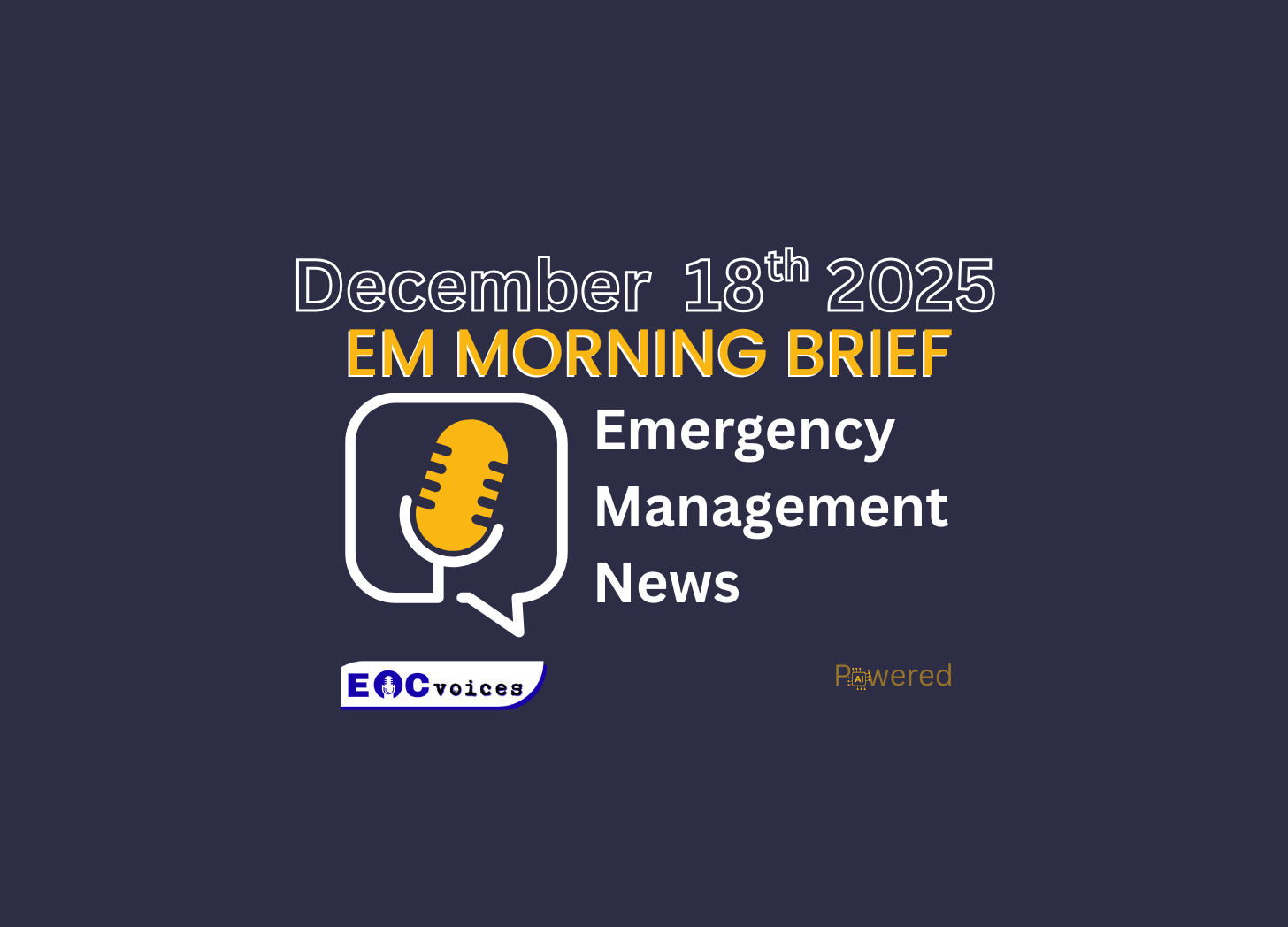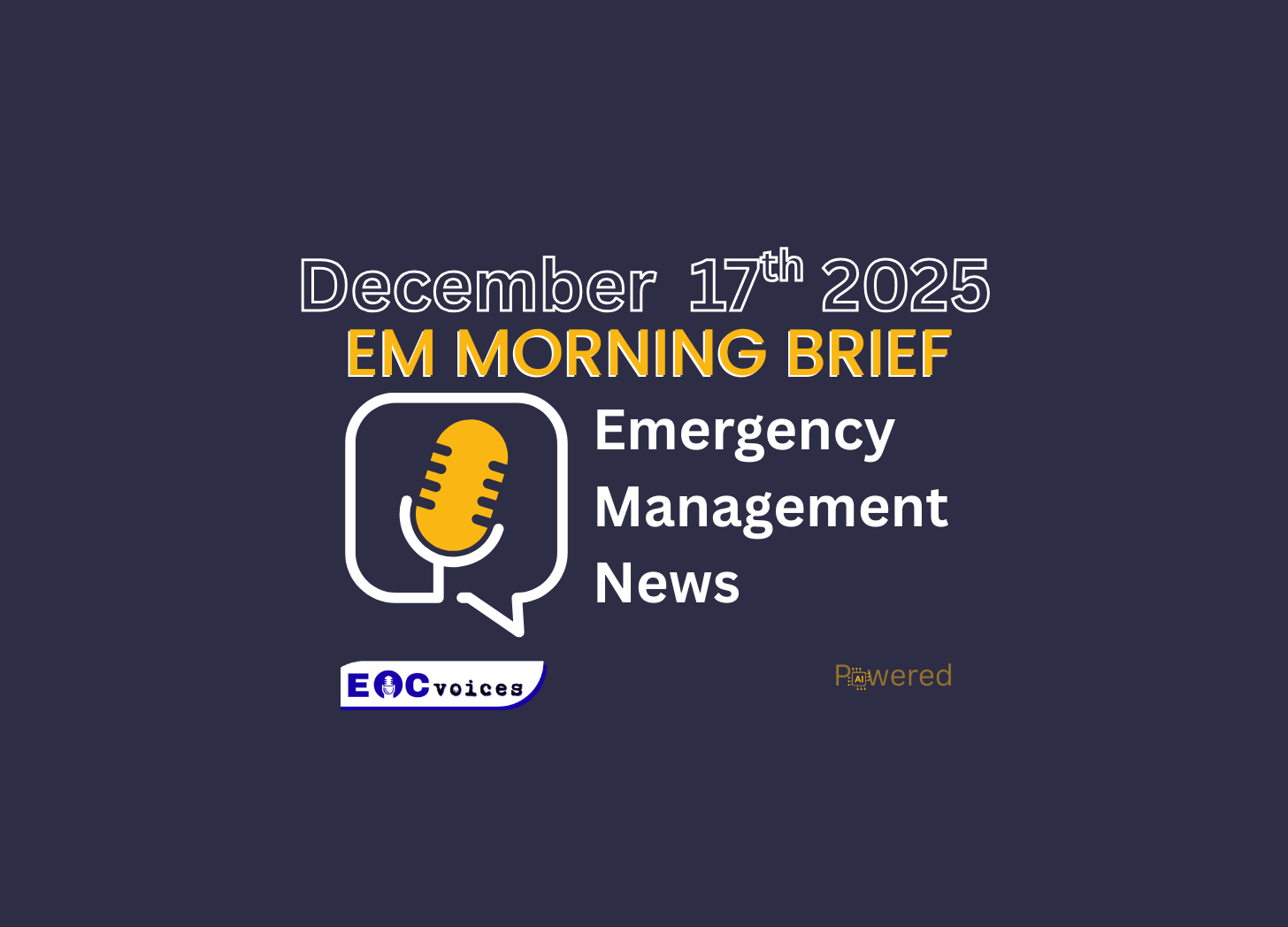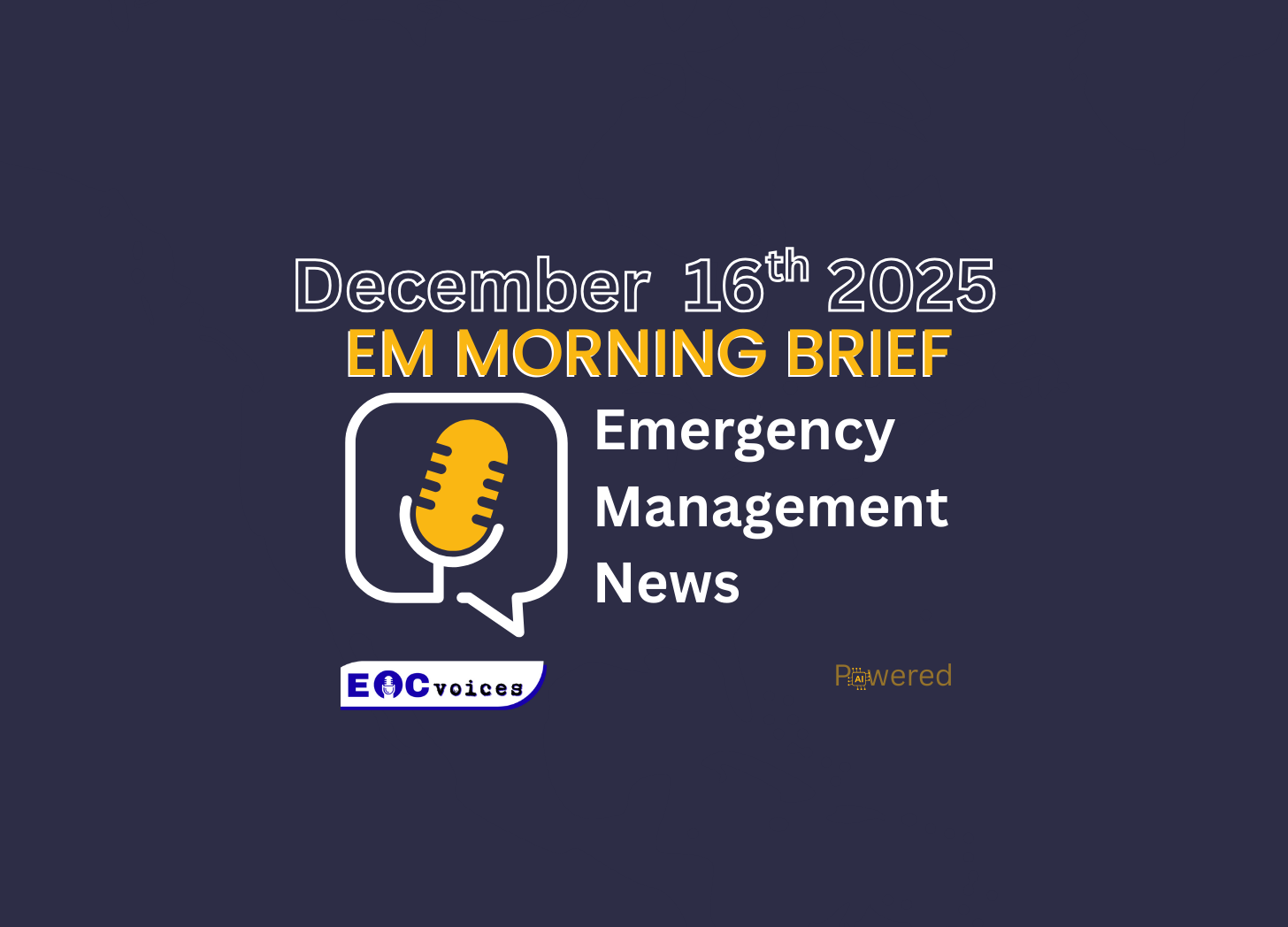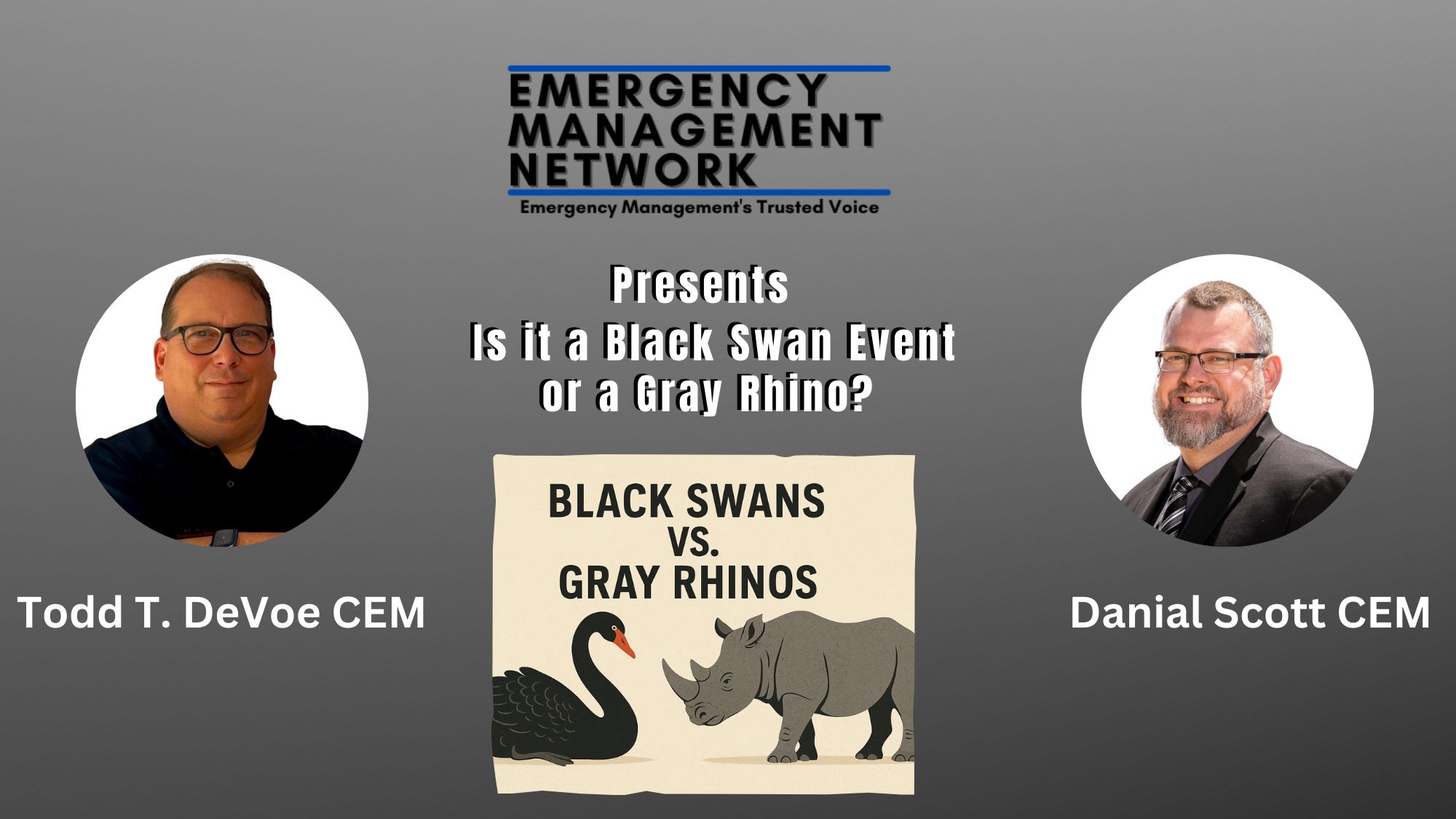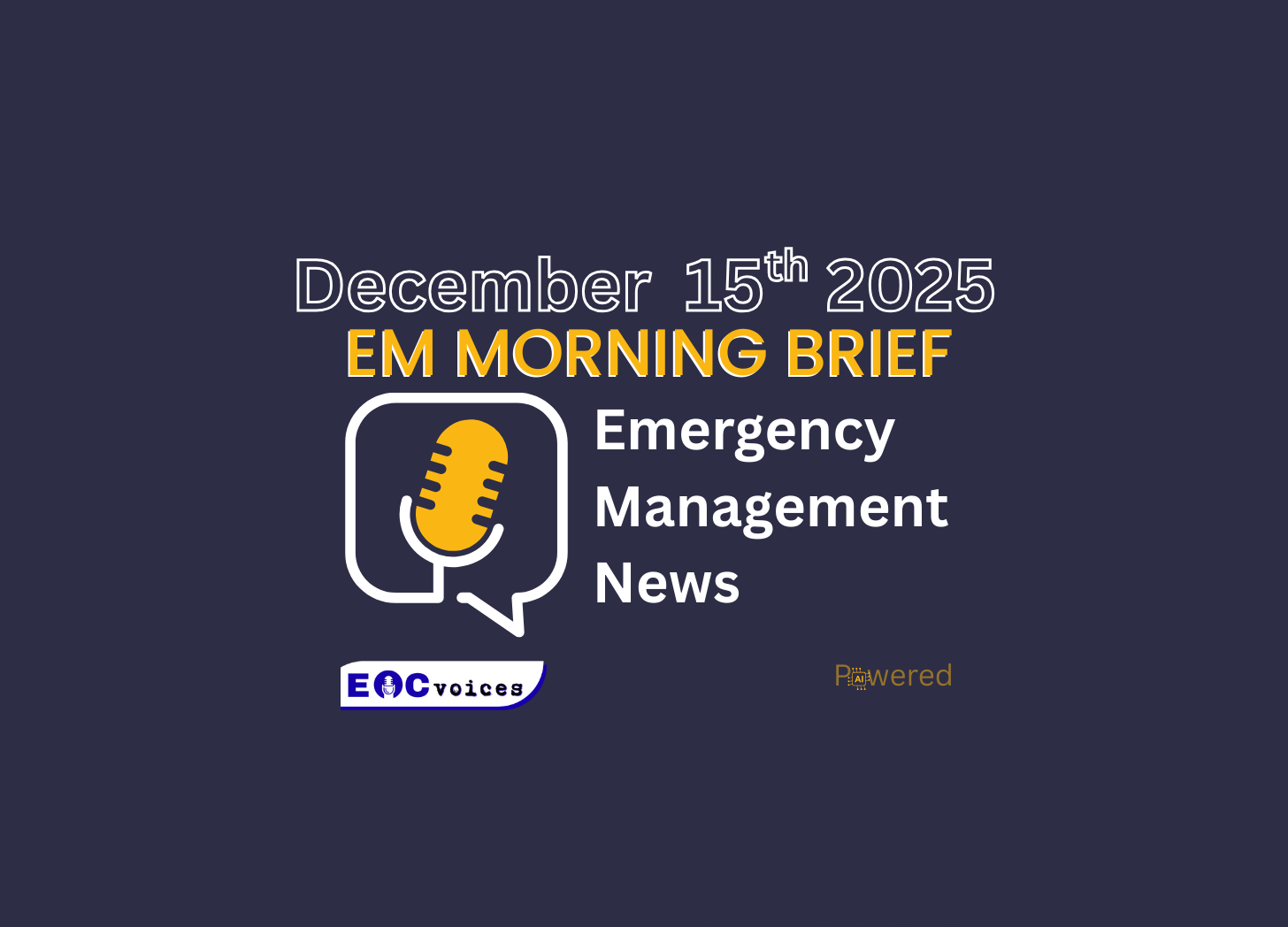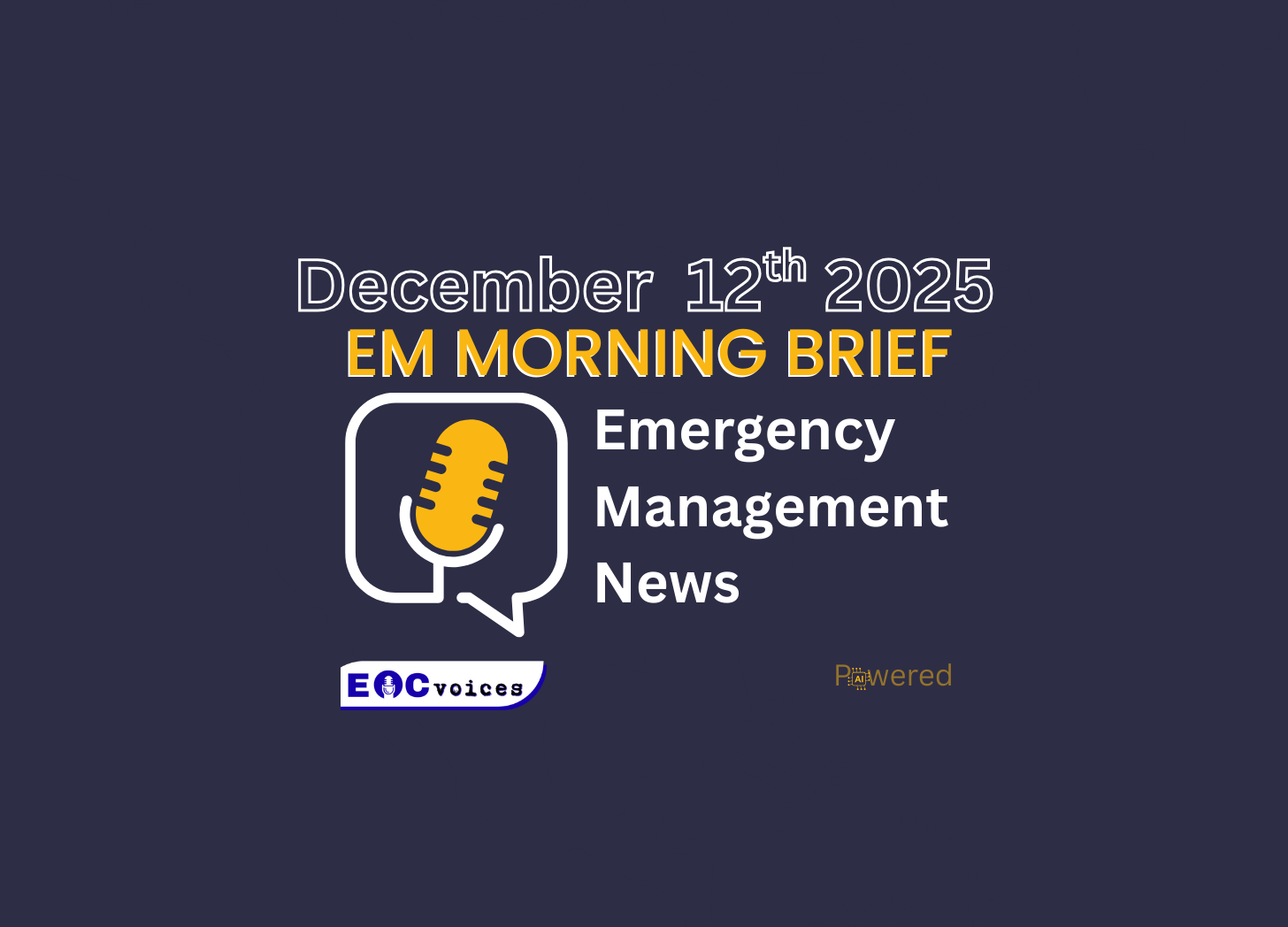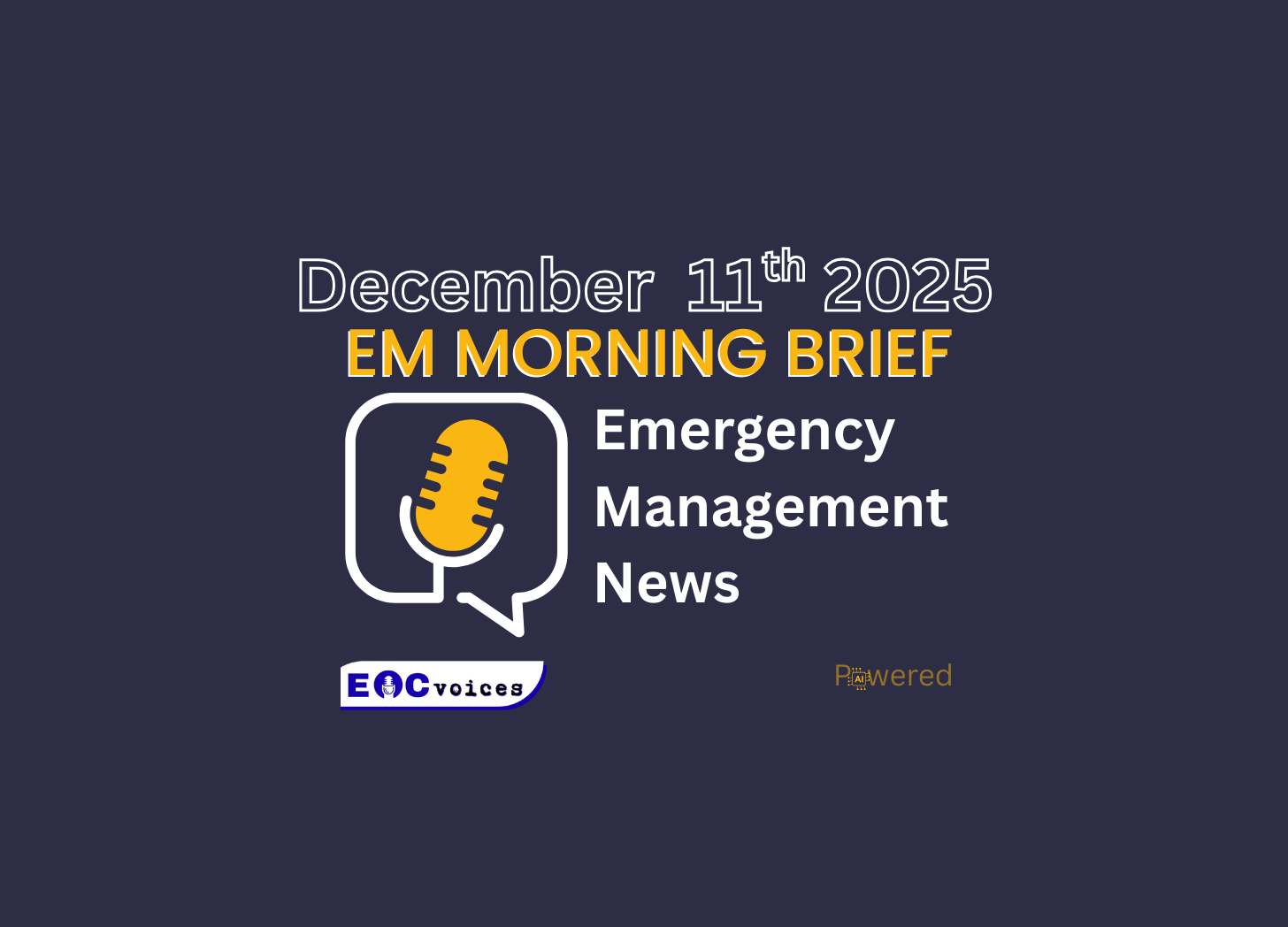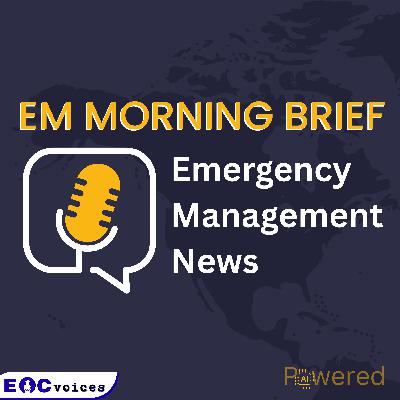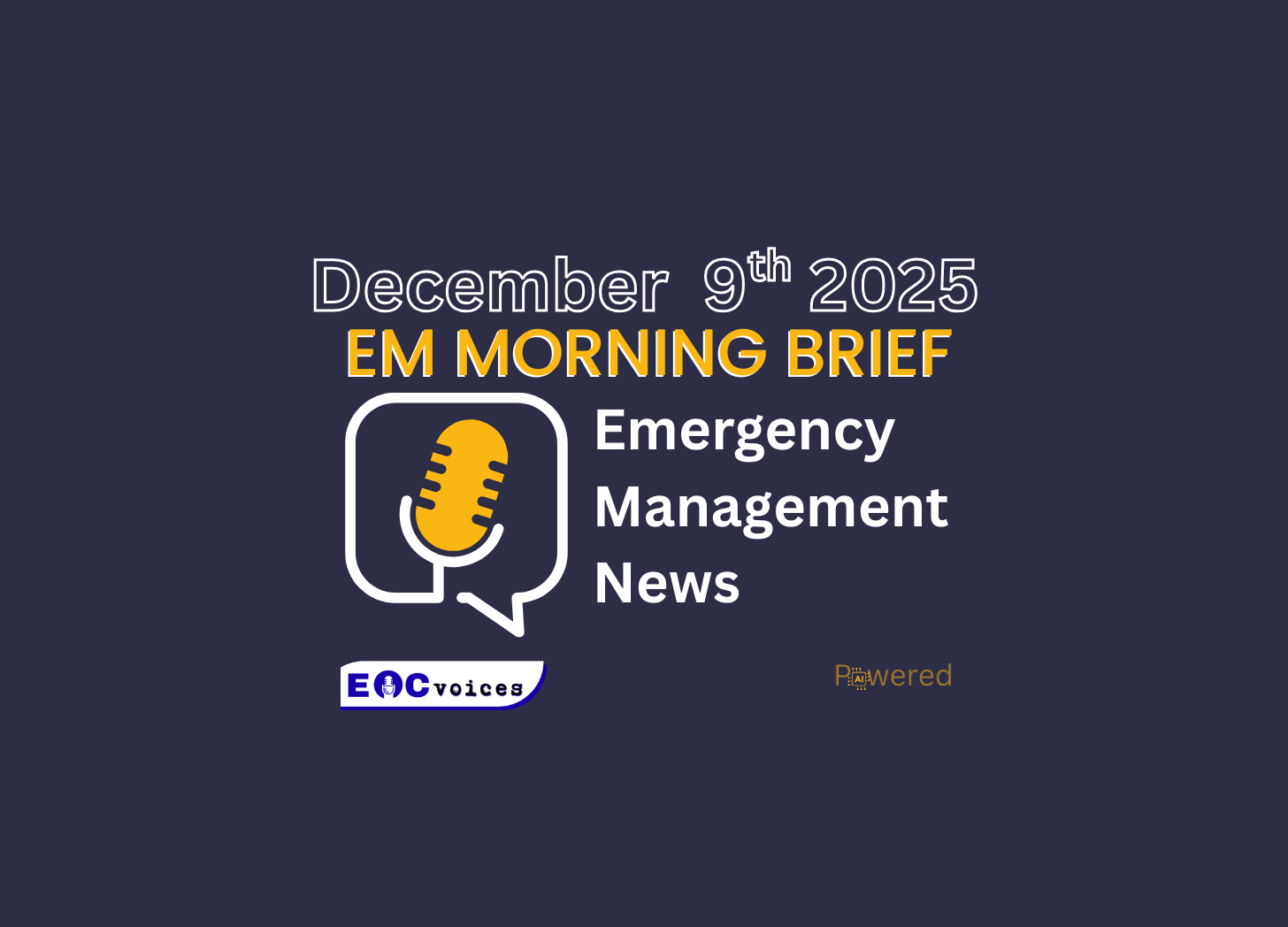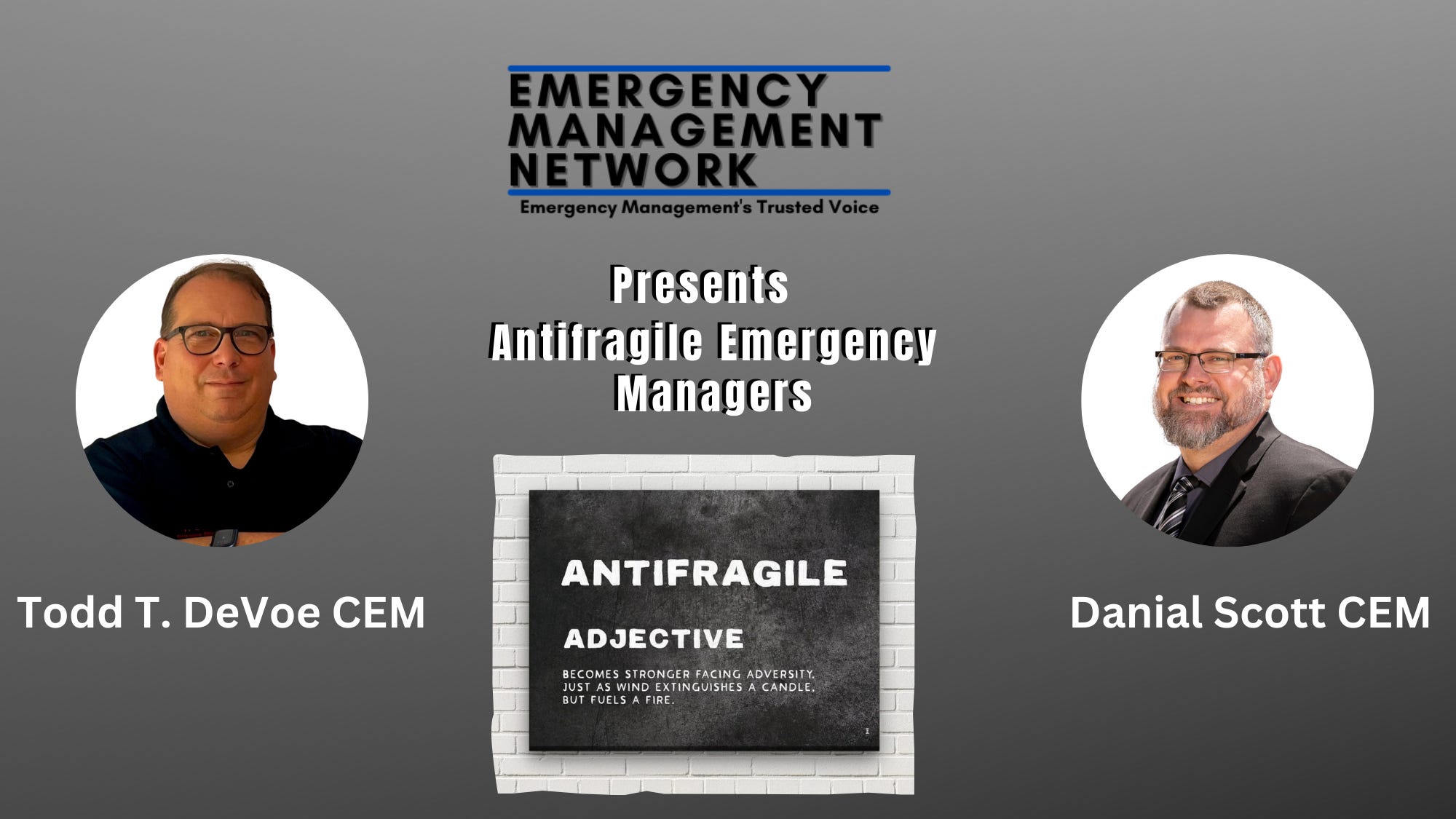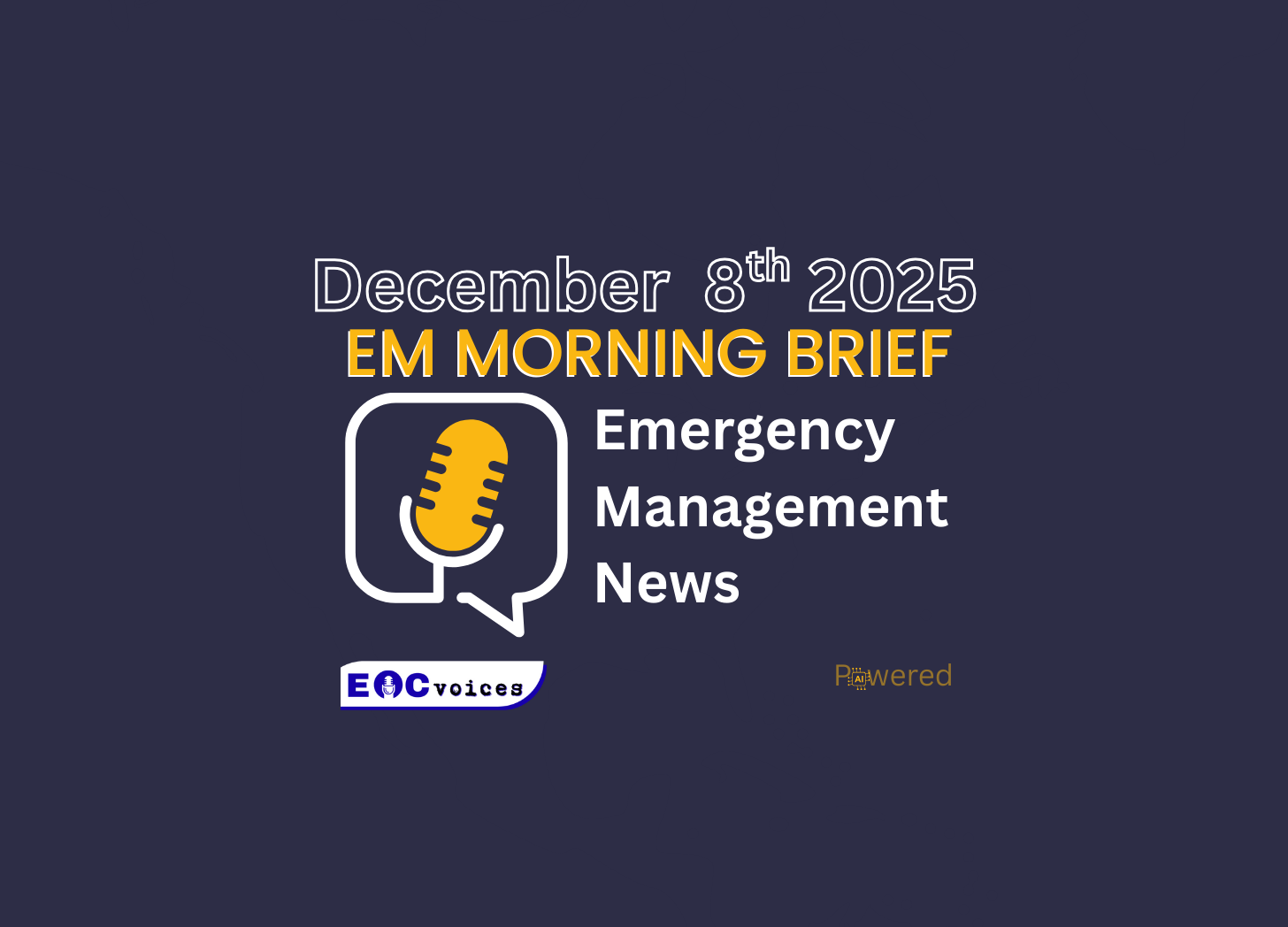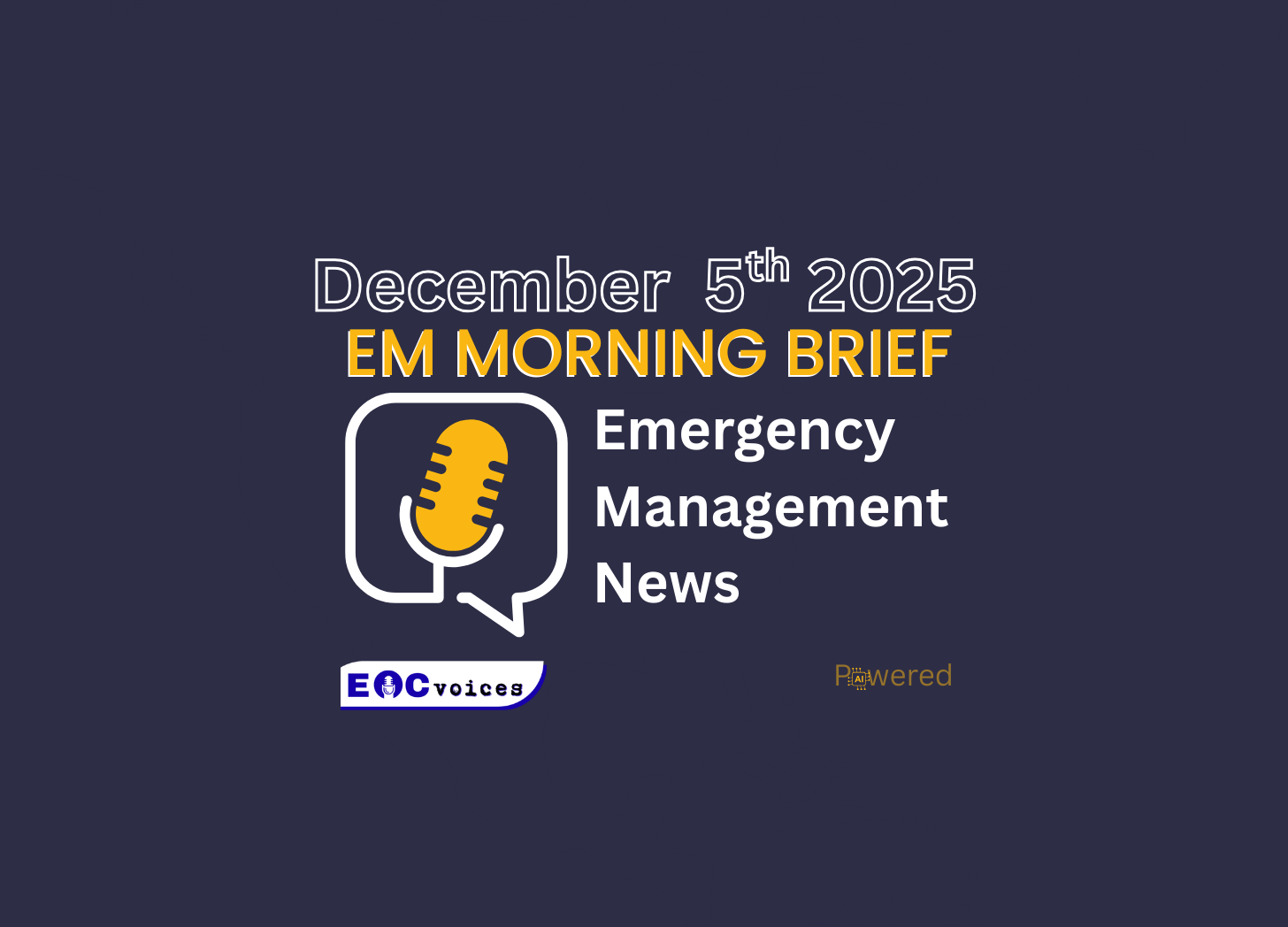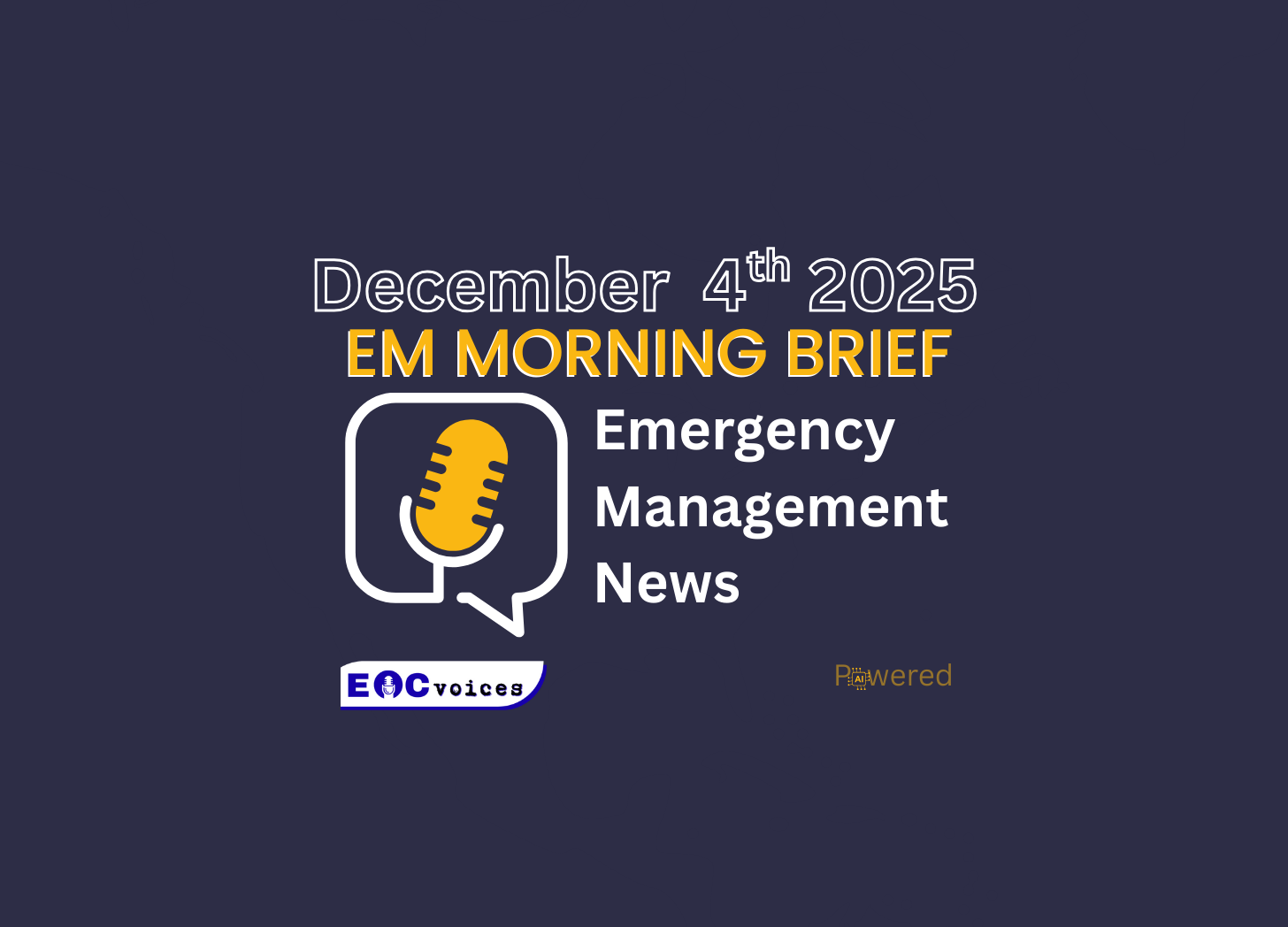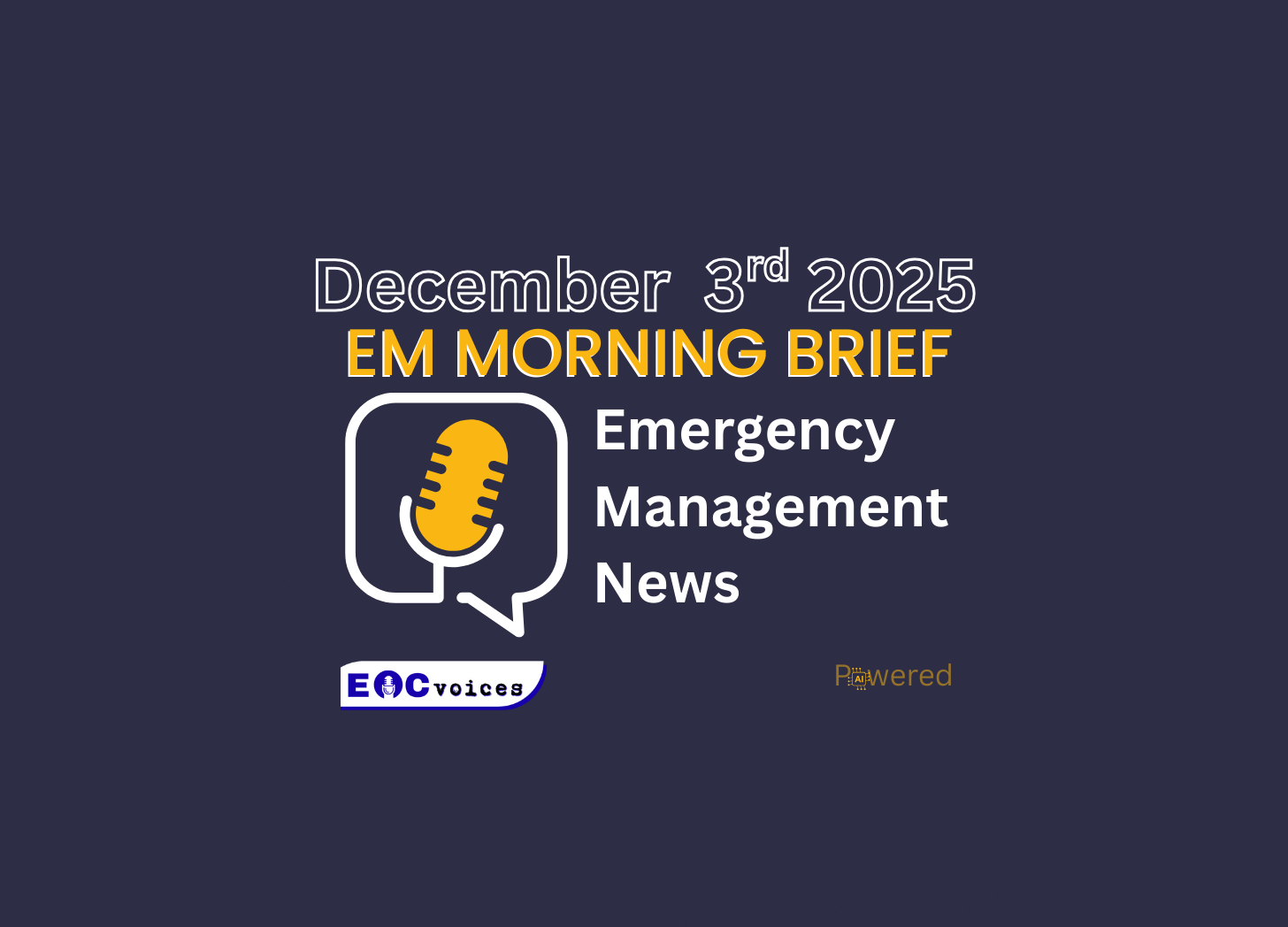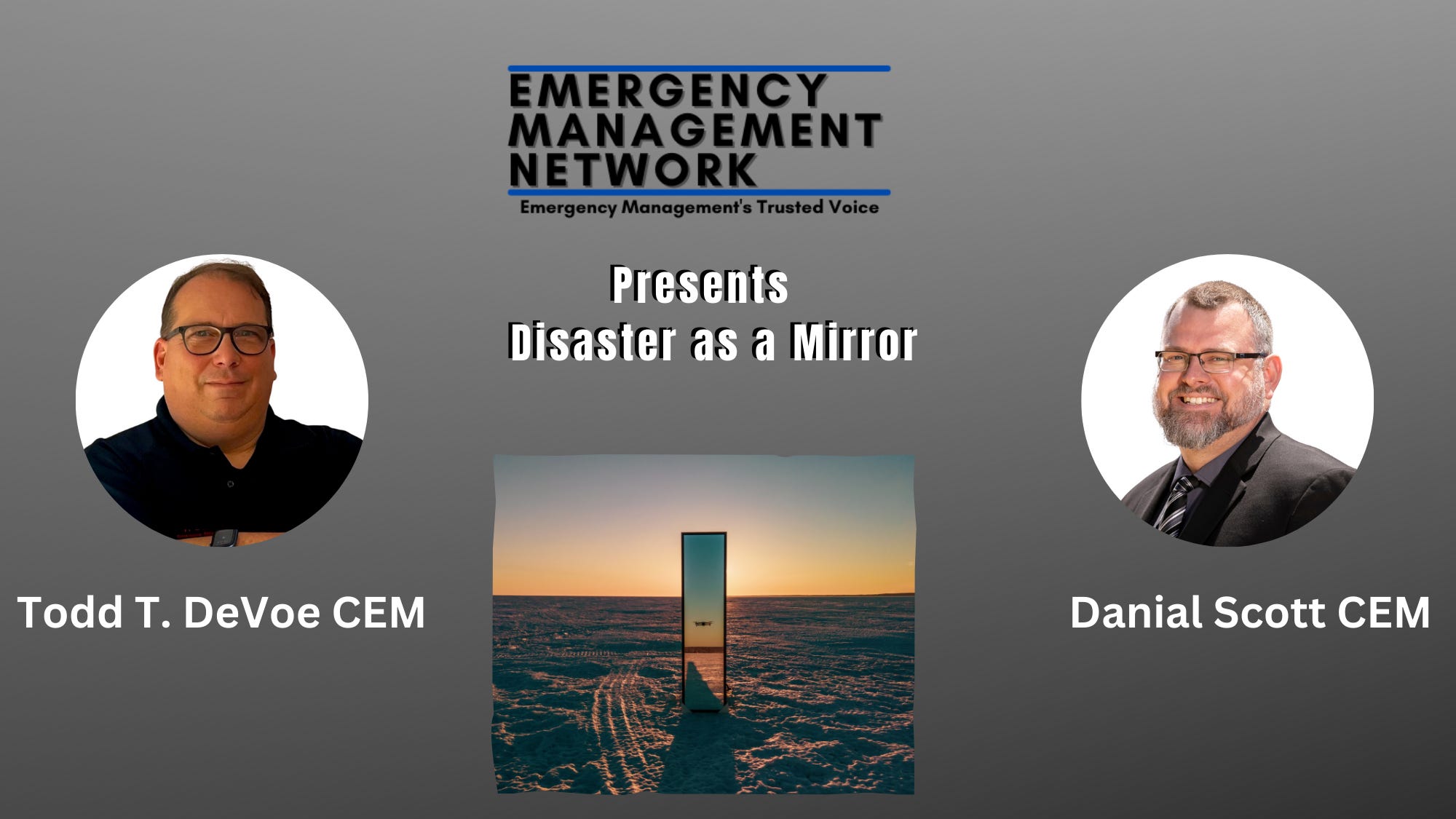Discover The Emergency Management Network Podcast
The Emergency Management Network Podcast

The Emergency Management Network Podcast
Author: Todd T. De Voe
Subscribed: 41Played: 204Subscribe
Share
© Emergency Management Network
Description
This podcast features strategies and advice from today’s leaders and experts in emergency management. Its purpose is to empower and enrich current and future leaders.
emnetwork.substack.com
emnetwork.substack.com
299 Episodes
Reverse
The primary focus of today’s discussion centers on the severe weather conditions affecting the Inland Northwest and the Pacific Northwest, characterized by strong winds capable of causing significant damage. We elucidate the National Weather Service’s warnings regarding gusts that may lead to the downing of trees and power lines, thereby creating hazardous travel conditions, particularly for high-profile vehicles. Furthermore, we advise individuals residing in the affected areas to secure loose outdoor items and to prepare for potential power outages while exercising heightened caution on exposed roads. Additionally, we provide a brief overview of the routine seismic activity recorded by the US Geological Survey, noting the occurrence of small earthquakes across various regions, including Southern California. In our concluding remarks, we remind our audience to remain vigilant and prioritize safety amidst these challenging weather circumstances.Takeaways:* The National Weather Service has issued warnings for strong winds across the Inland Northwest and Pacific Northwest.* Residents in affected areas should secure loose outdoor items and prepare for potential power outages.* Small earthquakes have been routinely recorded in Southern California and other regions in the west.* High wind warnings in Oregon indicate gusts that can cause significant travel hazards for high profile vehicles.* Winter weather advisories in North Central Washington may impact morning commutes due to accumulating snow.* Overall, no significant updates were reported from other states in the last 24 hours.Sources[USGS Latest Earthquakes | https://earthquake.usgs.gov/earthquakes/map/][NWS Watches/Warnings text | https://www.weather.gov/wwamap/wwatxtget.php?cwa=otx&wwa=all][NWS Watches/Warnings text | https://www.weather.gov/wwamap/wwatxtget.php?cwa=otx&wwa=all][NWS Portland forecast office update | https://www.weather.gov/pqr/][NWS Watches/Warnings text | https://www.weather.gov/wwamap/wwatxtget.php?cwa=otx&wwa=all] This is a public episode. If you'd like to discuss this with other subscribers or get access to bonus episodes, visit emnetwork.substack.com/subscribe
The primary focus of today’s brief centers on the significant impacts of a powerful Pacific storm train, which is anticipated to bring excessive rainfall and heavy snow across various regions, particularly California, Nevada, and the Pacific Northwest. We begin by addressing the heightened risk of flooding in California, where coastal downpours are likely to raise river levels and exacerbate travel difficulties due to road closures and chain controls in mountainous areas. As the storm progresses, we will see its effects extend into Nevada and other states, with advisories for high winds and winter weather being issued.Takeaways:* A powerful Pacific storm train is currently affecting multiple regions across the United States.* California faces a slight risk of excessive rainfall, impacting coastal areas and Sierra Nevada mountains.* Travelers should anticipate road closures and chain control requirements due to severe weather conditions.* Nevada has winter storm warnings in place, with significant snow expected in various counties.* Wind and rain are expected to increase in Washington, accompanied by flood warnings in certain areas.* Arizona will experience moisture from the Pacific storm, leading to potential flooding and winter weather advisories.Sources[USGS M4.5+ Past Day | https://earthquake.usgs.gov/earthquakes/feed/v1.0/summary/4.5_day.geojson][NWS Bay Area | https://www.weather.gov/mtr/][NWS Hanford (San Joaquin Valley/Sierra) | https://www.weather.gov/hnx/][NWS LOX Gale Warning | https://forecast.weather.gov/wwamap/wwatxtget.php?cwa=lox&wwa=gale+warning][WPC — Excessive Rainfall (CA Slight Risk today) | https://www.wpc.ncep.noaa.gov/qpf/ero.php?day=1&opt=curr][SFGATE — Bay Area flood watch & storm timing | https://www.sfgate.com/bayarea/article/flood-watch-bay-area-through-christmas-21256885.php][NWS Reno — Warnings/Travel briefing | https://www.weather.gov/rev/][NWS Las Vegas — Flood Watch & wind messaging | https://www.weather.gov/vef/][NWS Reno — Flood Watch text (issued 1:45 AM PST) | https://forecast.weather.gov/wwamap/wwatxtget.php?cwa=usa&wwa=flood+watch][NWS Portland — hazards | https://www.weather.gov/pqr/][WPC — CA-to-OR heavy rain corridor (Slight/Marginal) | https://www.wpc.ncep.noaa.gov/qpf/ero.php?day=1&opt=curr][NWS Seattle — hazards & hydrology | https://www.weather.gov/sew/][NWS Phoenix — Flood Watch & event timeline | https://www.weather.gov/psr/][NWS Flagstaff — winter headlines | https://www.weather.gov/fgz/][NWS Buffalo — Hazardous Weather Outlook (Lake Ontario counties) | https://www.weather.gov/buf/BUFHWOBUF][NWS Buffalo — hazards | https://www.weather.gov/buf/] This is a public episode. If you'd like to discuss this with other subscribers or get access to bonus episodes, visit emnetwork.substack.com/subscribe
The Emergency Management Network PodcastThe Books That Belong on Your BookshelfHosts: Todd T. DeVoe and Dan ScottFormat: Conversational, reflective, practitioner-focusedEpisode Theme: The books that shape how emergency managers think, not just how they check boxesEpisode DescriptionEmergency management isn’t mastered through binders alone. It’s shaped by the ideas we return to when plans fall short, and judgment takes over. In this episode, Todd DeVoe and Dan Scott step away from the news cycle and into something more enduring: the books every emergency manager should have within arm’s reach.This is not a “top ten list” or a graduate syllabus. It’s a conversation about foundations, leadership under pressure, community resilience, and the philosophical frameworks that quietly influence how we make decisions when the stakes are high.If you’ve ever asked yourself why you lead the way you do in crisis, this episode starts answering that question.Key Discussion Segments1. The Foundations of Emergency ManagementThe books that explain how the system works, why it evolved the way it did, and where the seams begin to show under stress.* Introduction to Emergency Management* Emergency Management: Principles and Practice* Disaster Response and RecoveryTodd and Dan discuss why these texts matter long after certification exams are over, and how they provide a shared professional language across jurisdictions and disciplines.2. Leadership When the Plan Runs OutDisasters don’t test paperwork; they test people.* Leadership in Disaster* The Unthinkable* Extreme OwnershipThe conversation explores accountability, decision-making under uncertainty, and why understanding human behavior is just as critical as understanding ICS.3. Community, Recovery, and ResilienceWhy recovery is social before it is structural.* Building Resilience* Resilience ThinkingDan and Todd unpack how social capital, trust, and networks often determine recovery outcomes more than funding formulas or infrastructure alone.4. Philosophy for Emergency ManagersThe quiet influences behind calm leadership and ethical decision-making.* Meditations* The Obstacle Is the Way* Man’s Search for MeaningTodd reflects on why philosophy belongs in the EOC and how these works help leaders remain grounded during prolonged, high-stress events.Why This Episode MattersEmergency management is a profession of ambiguity. When checklists end, books help shape judgment. This episode challenges listeners to think about their own professional bookshelf and ask what ideas they are carrying into the next crisis.Listener Takeaways* Why foundational texts still matter for seasoned practitioners* How leadership books outside EM sharpen emergency decision-making* The role of philosophy in crisis leadership and resilience* What your bookshelf says about how you approach uncertaintyNext Episode What books should emergency managers stop relying on?In the next episode, Todd and Dan take on outdated thinking, legacy doctrine, and why some “classics” may quietly undermine modern preparedness. This is a public episode. If you'd like to discuss this with other subscribers or get access to bonus episodes, visit emnetwork.substack.com/subscribe
The episode articulates the significant impact of a potent Pacific storm train, which continues to target the western region of the United States, particularly California and Washington. We delve into the widespread flood watches issued by the National Weather Service, affecting vast areas along the California coast and valleys, alongside heavy snowfall in the Sierra Nevada, which complicates mountainous travel. Additionally, we address the winter storm warning currently in effect for the Washington Cascades, where hazardous conditions prevail due to blowing snow. Our discussion further encompasses the emergency declaration approved by FEMA for Montana, aimed at providing federal support in response to recent flooding incidents. We conclude by emphasizing the need for vigilance and safety amidst these challenging weather conditions, while we continue to monitor ongoing developments across various states. A comprehensive examination of the ongoing meteorological conditions reveals a formidable Pacific storm train currently imposing significant weather events across the western regions of the United States. The National Weather Service has issued widespread flood watches encompassing much of California’s coastal and valley areas, while simultaneously, heavy snowfall is complicating travel through the Sierra Nevada mountains. This duality of weather phenomena underscores the potential for both flooding and treacherous travel conditions, particularly in the context of the Sierra, where snow accumulation is exacerbating the risks associated with winter travel. Further north, the Washington Cascades are under a winter storm warning, highlighting hazardous conditions including blowing snow and limited visibility, which pose serious risks to both residents and travelers alike. As we navigate through these intense weather patterns, it is imperative to remain vigilant and informed, as river flood warnings persist in various basins, reflecting the substantial impact these storms are having on local ecosystems and communities alike.Takeaways:* The National Weather Service has issued widespread flood watches across California’s coastal regions and valleys.* A potent Pacific storm is currently affecting the West, leading to hazardous weather conditions.* FEMA has approved an emergency declaration for Montana in light of recent flooding incidents.* Winter storm warnings are in effect for the Washington Cascades, indicating severe weather challenges ahead.* Flood warnings persist on several rivers, including the Skokomish, indicating ongoing minor flooding issues.* Minnesota is experiencing icy road conditions due to overnight freezing rain, affecting travel safety.Sources[FEMA | https://www.fema.gov/press-release/20251220/president-donald-j-trump-approves-emergency-declaration-montana][NWS San Diego | https://forecast.weather.gov/wwamap/wwatxtget.php?cwa=usa&wwa=flood+watch][NWS Bay Area | https://www.weather.gov/mtr/][NWS Sacramento | https://forecast.weather.gov/showsigwx.php?product1=Flood+Watch&warnzone=CAZ066][NWS Eureka (Eel River) | https://www.weather.gov/eka/][NWS Seattle | https://www.weather.gov/sew/][NWS Warning Text | https://forecast.weather.gov/wwamap/wwatxtget.php?cwa=sew&wwa=winter+storm+warning][NWS River Warning | https://forecast.weather.gov/wwamap/wwatxtget.php?cwa=usa&wwa=flood+warning][NWS Medford | https://www.weather.gov/mfr/][NWS Advisory Timing | https://forecast.weather.gov/MapClick.php?lat=43.1787&lon=-122.1389][NWS Spokane | https://forecast.weather.gov/showsigwx.php?firewxzone=IDZ101&product1=Winter+Weather+Advisory][Montana Governor | https://gov.mt.gov/Documents/GovernorsOffice/executiveorders/View?doc=EO112025DisasterDeclarationStatewideSevereWindEvent002.pdf][NWS Missoula | https://forecast.weather.gov/wwamap/wwatxtget.php?cwa=usa&wwa=winter+weather+advisory][NWS Fairbanks | https://forecast.weather.gov/wwamap/wwatxtget.php?cwa=usa&wwa=winter+weather+advisory][MnDOT 511 | https://511mn.org/list/events][MPR News | https://www.mprnews.org/story/2025/12/22/road-conditions-icy-schools-delayed-in-southern-minnesota] This is a public episode. If you'd like to discuss this with other subscribers or get access to bonus episodes, visit emnetwork.substack.com/subscribe
A powerful coast-to-coast storm continues to traverse the eastern United States, bringing with it a myriad of severe weather conditions. The National Weather Service has issued flood watches and river flood warnings for western Washington and northwest Oregon, while high winds affect the Northern Rockies and High Plains. As we delve into the specifics of this storm’s impact, we will also discuss the emergence of lake effect snow and the potential for flash freeze slick spots downwind of the Great Lakes. Furthermore, wind advisories are in effect for parts of the Mid Atlantic as the cold front advances offshore. We will also address seismic activity, noting several small to moderate earthquakes recorded off the coast of Alaska without significant damage reported. Join us as we explore these weather phenomena and their implications for various states across the nation. The latest briefing commences with a comprehensive overview of the meteorological conditions affecting the United States on December 19th, 2025. A formidable coast-to-coast storm is currently traversing the nation, prompting the National Weather Service (NWS) to issue flood watches and river flood warnings across western Washington and northwest Oregon. In addition, high winds are impacting the Northern Rockies and the High Plains, creating perilous travel conditions and potential hazards for local populations. Furthermore, the Great Lakes region is experiencing lake effect snow and flash freeze conditions, leading to dangerous slick spots that may exacerbate the challenges faced by commuters.Takeaways:* Today, a powerful coast to coast storm continues to move eastward across the nation, bringing severe weather.* The National Weather Service has issued flood watches and river flood warnings for western Washington and northwest Oregon.* High wind warnings have been issued for the Pribilof Islands with gusts reaching 75-80 mph, creating hazardous conditions.* Dense fog is present in California’s Central Valley, reducing visibility significantly and causing travel delays.* In Michigan, winter weather advisories remain in effect, predicting additional lake effect snow along the Lake Michigan shore.* Oregon faces ongoing flood warnings as an atmospheric river approaches, increasing the risk of landslides and flooding.Sources[NWS Anchorage overview & warnings | https://www.weather.gov/afc][NWS AFC High Wind pages | https://www.weather.gov/afc/HighWindWarningPribilofs , https://www.weather.gov/afc/HighWindBeringStormReview][NWS Hanford — Dense Fog Advisory & hazards | https://www.weather.gov/hnx/][Caltrans QuickMap travel info | https://quickmap.dot.ca.gov][NWS Baltimore/Washington — Wind Advisory & HWO | https://www.weather.gov/lwx/ https://forecast.weather.gov/showsigwx.php?warnzone=MDZ013&product1=Wind+Advisory][Washington Post Capital Weather Gang live updates | https://www.washingtonpost.com/weather/2025/12/19/dc-weather-live-updates-stormy-windy/][NWS Grand Rapids advisory summary | https://www.weather.gov/wwamap/wwatxtget.php?cwa=grr&wwa=all][NWS Detroit/Pontiac HWO & gales | https://forecast.weather.gov/product.php?issuedby=DTX&product=HWO&site=NWS , https://www.weather.gov/dtx/][FEMA—Branch County flood maps meeting | https://www.fema.gov/press-release/branch-county-residents-invited-review-flood-maps][NWS Billings hazards | https://www.weather.gov/byz/][NWS statewide wind hazards page | https://www.weather.gov/byz/montana_statewide_information][NWS Buffalo advisories & marine gales | https://forecast.weather.gov/showsigwx.php?warnzone=PAZ001&product1=Lake+Effect+Snow+Warning, https://www.weather.gov/buf/BUFHWOBUF][WBEN/Audacy local briefing | https://www.audacy.com/wben/news/weather/strong-winds-falling-temps-and-rain-transitions-to-snow][NWS Portland—flood warnings & watches | https://forecast.weather.gov/showsigwx.php?product1=Flood+Warning&warnzone=ORZ111 https://www.weather.gov/pqr/][OPB regional forecast update | https://www.opb.org/article/2025/12/18/atmospheric-river-flooding-oregon-washington-weather-forecast/][NWS Seattle—Flood Warnings/Watch text | https://www.weather.gov/wwamap/wwatxtget.php?cwa=sew&wwa=all][NWS Seattle office dashboard | https://www.weather.gov/sew/][NWS Cheyenne—High Wind Warning text & local page | https://forecast.weather.gov/wwamap/wwatxtget.php?cwa=cys&wwa=high+wind+warning , https://forecast.weather.gov/MapClick.php?textField1=41.1454&textField2=-104.792][Cowboy State Daily regional brief | https://cowboystatedaily.com/2025/12/18/don-days-wyoming-weather-forecast-friday-december-19-2025/] This is a public episode. If you'd like to discuss this with other subscribers or get access to bonus episodes, visit emnetwork.substack.com/subscribe
The primary focus of today’s discussion centers on the severe weather conditions currently impacting the Pacific Northwest and surrounding regions. A high-impact Pacific storm is delivering substantial rainfall, strong winds, and snowfall across various areas, raising significant concerns about flooding and hazardous travel conditions. As we navigate through the complexities of this weather event, it is imperative to recognize the ongoing flood warnings, winter hazards, and the risks posed by blizzard conditions in states such as North Dakota and Montana. Furthermore, we shall highlight the critical situation in Washington, where record flooding has necessitated numerous rescues and evacuations. We will continue to monitor these developments closely as we provide updates on the evolving weather patterns and their implications.The recent episode of our podcast delves into the multifaceted impacts of a powerful Pacific storm currently affecting the western United States, particularly in Washington and Oregon. Our discussion begins with a detailed analysis of the meteorological phenomena at play, including the significant precipitation and high winds that have resulted in severe flooding across these regions. We examine the National Weather Service’s ongoing flood warnings and advisories, which highlight the urgency of the situation as urban flooding and hazardous conditions threaten the safety and well-being of residents. Furthermore, we explore the implications of saturated soils, which have led to widespread power outages and fatalities, emphasizing the dire need for preparedness in the face of such natural disasters.As the episode progresses, we provide a state-by-state breakdown of the weather conditions, detailing the specific challenges faced by each area. In California, for instance, we discuss the anticipated rainfall and the potential for minor urban flooding, while in Idaho, we highlight the blizzard conditions and the resultant dangers posed to travelers. Our analysis does not shy away from the human aspect of these events, as we recount reports of fatalities linked to the extreme weather, underscoring the importance of vigilance and community response during such crises. By the conclusion of our discourse, we aim to impart a comprehensive understanding of the current storm’s impact, fostering awareness and preparedness among our listeners.Takeaways:* A potent Pacific storm is currently causing significant flooding and hazardous weather across the Northwest region. * Wind advisories and winter weather warnings have been issued for multiple states due to severe conditions. * The ongoing weather events have resulted in major power outages and numerous emergency responses throughout the affected areas. * Travel remains extremely dangerous in regions experiencing blizzard conditions and high winds, particularly in North Dakota and Montana. * Flood warnings and advisories continue to be in effect as heavy rainfall persists in western Oregon and California. * Authorities are urging residents to remain vigilant and prepared for changing weather conditions and potential evacuations. Sources[NWS Eureka AFD | https://forecast.weather.gov/product.php?format=CI&glossary=1&highlight=off&issuedby=EKA&product=AFD&site=NWS&version=1][NWS Bay Area Dense Fog Advisory | https://www.weather.gov/wwamap/wwatxtget.php?cwa=lox&wwa=all][NWS Denver/Boulder AFD | https://www.weather.gov/bou/afd][NWS Denver/Boulder Hazards | https://www.weather.gov/bou/][NWS Pocatello Hazards | https://www.weather.gov/pih/][AP | https://apnews.com/article/fe814b86139b6d30b8e19f5f1d44e47e][NWS Duluth Hazards | https://www.weather.gov/dlh/][NWS Duluth Marine | https://www.weather.gov/dlh/marine][NWS Glasgow | https://www.weather.gov/ggw/][NWS text for MT/ND blizzard | https://www.weather.gov/wwamap/wwatxtget.php?cwa=bis&wwa=all][NWS Bismarck | https://www.weather.gov/bis/][BIS Decision Support Blizzard Brief (PDF) | https://www.weather.gov/media/bis/DssPacket.pdf][NWS Portland Briefing/Hazards | https://www.weather.gov/pqr/][NWS Coastal Flood Advisory | https://www.weather.gov/wwamap/wwatxtget.php?cwa=pqr&wwa=all][NWS/WPC ERO | https://www.wpc.ncep.noaa.gov/qpf/excessive_rainfall_outlook_ero.php][NWS Aberdeen | https://www.weather.gov/abr/][NWS Seattle Hazards | https://www.weather.gov/sew/][AP regional impacts | https://apnews.com/article/fe814b86139b6d30b8e19f5f1d44e47e][NWS Cheyenne High Wind Warning | https://www.weather.gov/cys/highwind][NWS Cheyenne Hazards | https://www.weather.gov/cys/] This is a public episode. If you'd like to discuss this with other subscribers or get access to bonus episodes, visit emnetwork.substack.com/subscribe
The salient point of our discussion today centers on the impending severe weather conditions forecasted to affect multiple regions, particularly as a formidable Pacific storm approaches from the Northwest. This meteorological event is anticipated to bring damaging winds, mountain snow, and localized blizzard conditions across the Northern Rockies and Plains. Furthermore, we delve into the ongoing flood response in Western Washington, where the region grapples with the aftermath of excessive rainfall, compounded by river warnings and landslide risks as additional weather fronts approach. We also highlight the potential for hazardous travel conditions due to high winds and snow in various states, including North Dakota and Montana, as well as the growing concerns over winter storm watches and blizzard conditions in the northern plains. As we progress through our analysis, we will remain vigilant in tracking river stages, wind advisories, and the timing of forthcoming storms, ensuring that our audience is well-informed and prepared for the evolving weather scenarios.A thorough examination of the current meteorological landscape reveals the intricate dynamics of a formidable Pacific storm traversing the United States, particularly as it approaches the Northern Rockies and Plains. This storm is characterized by its capacity to generate damaging winds ranging from 50 to 70 mph, coupled with significant snowfall and the potential for localized blizzard conditions. The podcast meticulously unpacks the repercussions of this weather event, particularly for Western Washington, which is currently in a state of flood response following an extensive period of heavy precipitation. The discussion focuses on the heightened risks of river flooding and landslides, a situation exacerbated by the saturated soils resulting from recent rainfall. As the storm progresses, listeners are informed of the potential for additional fronts to exacerbate these conditions, emphasizing the ongoing vulnerability of the region.The narrative further extends to the specific weather advisories across various states, detailing the high wind advisories and renewed flood threats that are expected to emerge in Northwest Oregon and Southwest Washington. The podcast dissects the implications of these advisories, particularly for transportation and infrastructure, as well as the efforts of local and national weather services to keep the public informed. The dangers posed by high winds and blizzard conditions in the High Plains are highlighted, illustrating the widespread impact of the storm across state lines. The podcast adeptly conveys the seriousness of the situation, advocating for public awareness and action in response to the impending weather challenges.As the episode draws to a close, the discussion encapsulates the necessity for vigilance and preparedness in the face of such formidable weather phenomena. It calls upon listeners to remain abreast of the evolving circumstances, emphasizing the importance of heeding warnings and taking precautionary measures to ensure safety. Ultimately, the podcast serves as an invaluable resource for understanding the complexities of severe weather and underscores the imperative of community resilience in the face of natural adversities.Takeaways:* The Pacific storm is expected to bring significant damaging winds and snow across various regions today. * Western Washington continues to face serious flooding issues following an extended period of heavy rainfall. * High wind warnings and advisories are in effect across numerous states, indicating hazardous conditions. * Travel disruptions are anticipated due to heavy winds and potential blizzard conditions in the northern regions. * Forecasters predict a powerful atmospheric river to impact the area with heavy rain and rising rivers soon. * Weather advisories highlight the risk of downed trees and utility outages due to saturated soils. Sources[WPC | https://www.wpc.ncep.noaa.gov][NWS Seattle | https://www.weather.gov/sew/][USGS Latest Earthquakes (map) | https://earthquake.usgs.gov/earthquakes/map/?extent=16.8,-137.2&extent=55.0,-52.8&listOnlyShown=true][NOAA SWPC | https://www.swpc.noaa.gov/products/forecast-discussion][NWS Seattle — AFD/hazards | https://forecast.weather.gov/product.php?issuedby=SEW&product=AFD&site=sew][NWS Seattle homepage | https://www.weather.gov/sew/][AP recap of state impacts | https://apnews.com/article/5a5d085e96e98d24c96a889b4d7d8e6c][WSDOT | https://wsdot.wa.gov/][NWS Portland hazards | https://www.weather.gov/pqr/][NWS Pendleton alert (media relay) | https://ktvz.com/weather/alerts-weather/2025/12/17/high-wind-warning-issued-december-17-at-134am-pst-until-december-17-at-400pm-pst-by-nws-pendleton-or/][ODOT TripCheck closures | https://www.tripcheck.com/DynamicReports/Report/RoadConditions][NWS Bay Area AFD — key messages | https://forecast.weather.gov/product.php?issuedby=MTR&product=AFD&site=mtr][WPC Excessive Rainfall Outlook overview | https://www.wpc.ncep.noaa.gov][NWS Boise AFD/advisories | https://forecast.weather.gov/product.php?issuedby=BOI&product=AFD&site=BOI][NWS Pocatello High Wind Warning | https://forecast.weather.gov/showsigwx.php?warnzone=IDZ073&product1=High+Wind+Warning][Boise hazards | https://www.weather.gov/boi/][NWS Great Falls/TFX warnings | https://forecast.weather.gov/wwamap/wwatxtget.php?cwa=byz&wwa=all][East Glacier hazard page | https://forecast.weather.gov/MapClick.php?lat=48.4438&lon=-113.2255][NWS Cheyenne warnings text | https://www.weather.gov/wwamap/wwatxtget.php?cwa=cys&wwa=all][NWS Denver/Boulder — point forecast showing High Wind Warning | https://forecast.weather.gov/MapClick.php?lat=40.56&lon=-105.07][WPC national hazards note | https://www.wpc.ncep.noaa.gov][NWS Bismarck state forecast product | https://forecast.weather.gov/product.php?issuedby=ND&product=SFP&site=AKQ][NWS Grand Forks DSS/Blizzard potential PDF | https://www.weather.gov/media/fgf/DssPacket.pdf][NWS Rapid City AFD | https://forecast.weather.gov/product.php?issuedby=UNR&product=AFD&site=UNR][NWS Rapid City High Wind Warning text | https://forecast.weather.gov/showsigwx.php?warnzone=SDZ076&product1=High+Wind+Warning][NWS North Platte HWO | https://forecast.weather.gov/product.php?issuedby=LBF&product=HWO&site=NWS][WFO North Platte hazards map | https://www.weather.gov/lbf/][NWS Salt Lake City homepage advisory | https://www.weather.gov/slc/][SLC point forecast showing Wind Advisory | https://forecast.weather.gov/MapClick.php?lat=40.7585&lon=-111.8881][NWS Duluth hazards | https://www.weather.gov/dlh/][NWS Grand Forks web brief | https://www.weather.gov/fgf/] This is a public episode. If you'd like to discuss this with other subscribers or get access to bonus episodes, visit emnetwork.substack.com/subscribe
This podcast episode provides a comprehensive overview of the significant weather events currently affecting various regions, with a particular emphasis on the hazardous conditions prevalent in the Pacific Northwest. The National Weather Service has issued winter storm warnings for the Washington Cascades, predicting an accumulation of snow ranging from 10 to 36 inches, accompanied by ridge gusts reaching up to 65 miles per hour. Furthermore, the episode highlights the ongoing flooding situation in the Skagit River area near Mount Vernon, where major flooding is anticipated, prompting an extension of the flood warning into Friday. In addition, we examine the winter storm warnings affecting Juneau in Alaska, as well as the persistent lake effect snow impacting parts of New York. The episode concludes with a reminder for listeners to remain vigilant and heed local advisories regarding these severe weather conditions.A comprehensive analysis of the current meteorological conditions reveals a significant winter storm warning in effect across the Pacific Northwest, particularly impacting the Washington Cascades. The National Weather Service has forecasted an alarming accumulation of snow ranging from ten to thirty-six inches, accompanied by ridge gusts reaching up to sixty-five miles per hour. This substantial snowfall is anticipated to commence in the late afternoon and persist through Wednesday night, thereby creating hazardous travel conditions and raising concerns for residents in the affected areas. Moreover, the Skagit River is experiencing notable flooding, with warnings extended until Friday, underscoring the urgency for vigilance and preparedness among local communities.In the broader context of weather phenomena, Alaska’s Panhandle is similarly grappling with winter storm warnings, predicting an additional three to seven inches of snowfall, coupled with gusty winds of thirty-five to forty miles per hour. These conditions are expected to pose challenges for both residents and travelers alike. The Great Lakes region is not exempt from winter weather, as lake effect snow continues to affect parts of New York, particularly Jefferson and Lewis counties, where visibility may be severely compromised by intense snow bands producing rapid accumulations and slick road conditions. Such developments necessitate heightened awareness and adherence to safety protocols as the region navigates through these tumultuous winter conditions.Takeaways:* The Pacific Northwest is currently experiencing severe winter storm conditions and hazards. * The National Weather Service has issued winter storm warnings for multiple regions until Wednesday night. * Significant flooding is forecasted near Mount Vernon, affecting low-lying areas and access. * Alaska’s Panhandle continues to face winter storm warnings with additional snowfall expected today. * Cold temperatures persist in North Carolina, with wind chills posing risks to sensitive populations. * Lake effect snow continues to impact visibility and road conditions in parts of New York. Sources[NWS Juneau | https://www.weather.gov/wwamap/wwatxtget.php?cwa=usa&wwa=all][NWS Los Angeles/Oxnard | https://forecast.weather.gov/wwamap/wwatxtget.php?cwa=hnx&wwa=all][NWS Monterey Marine | https://forecast.weather.gov/wwamap/wwatxtget.php?cwa=hnx&wwa=all] [NWS Honolulu | https://forecast.weather.gov/wwamap/wwatxtget.php?cwa=usa&wwa=high+surf+advisory][NWS Wilmington NC | https://www.weather.gov/ilm/aviation][NWS Buffalo | https://www.weather.gov/buf/BUFHWOBUF][NWS Seattle | https://forecast.weather.gov/wwamap/wwatxtget.php?cwa=SEW&wwa=flood+warning][NWS Seattle | https://forecast.weather.gov/wwamap/wwatxtget.php?cwa=usa&wwa=winter+storm+warning] This is a public episode. If you'd like to discuss this with other subscribers or get access to bonus episodes, visit emnetwork.substack.com/subscribe
Show NotesEmergency management often explains breakdowns through the lens of surprise, yet many of the hazards shaping our communities were visible long before impact. Todd and Dan unpack the difference between Black Swan events, which are genuinely rare and difficult to predict, and Gray Rhinos, which are highly probable, high-impact threats that are acknowledged but repeatedly deferred. The discussion explores how normalcy bias, political incentives, and institutional design can lead to the normalization of known risks and why mislabeling Gray Rhinos as Black Swans undermines resilience and professional credibility.Topics covered include:* How Black Swan events are defined and why they are often misunderstood* The concept of Gray Rhinos and how visible risks become politically inconvenient* Why emergency management defaults to the language of surprise* Normalcy bias and the danger of mistaking familiarity for safety* The gap between identifying risk and acting on it* Why mitigation and capacity building remain undervalued* How governance incentives shape preparedness outcomesKey TakeawayMost disasters are not shocking because they were unpredictable; they are devastating because they were postponed. Emergency management succeeds not by reacting well to surprise, but by refusing to ignore what is already charging straight at us. This is a public episode. If you'd like to discuss this with other subscribers or get access to bonus episodes, visit emnetwork.substack.com/subscribe
The primary focus of today’s discussion centers upon the ongoing adverse weather conditions impacting various regions across the United States. As articulated, the National Weather Service has issued numerous warnings and advisories, particularly in the east and Great Lakes, where lake effect snow and severe cold conditions persist. Furthermore, we delve into the flood warnings affecting the Skagit River and the repercussions of a recent magnitude 4.0 earthquake in California, which, while not resulting in significant damage, has prompted caution regarding aftershocks. The episode also addresses hazardous travel conditions in the Los Angeles area due to dense fog and high winds in Montana, underscoring the diverse and severe weather phenomena currently in play. We conclude with a reminder of the importance of preparedness as these conditions evolve, urging listeners to prioritize their safety amidst these challenges.A comprehensive overview of the current meteorological conditions reveals a predominantly weather-driven scenario with significant implications for various regions across the United States. The National Weather Service has issued lake effect snow warnings for areas adjacent to Lakes Erie and Ontario, highlighting the persistent and severe cold that dominates the eastern parts of the country, while freeze alerts extend precariously down to the northern Gulf Coast. The discussion further elaborates on the ongoing flood crisis in Washington State, exacerbated by another deluge of rain from the Cascade Mountains, necessitating renewed vigilance as levels surge above flood stage once more. The seismic activity is also noteworthy, as a magnitude 4.0 earthquake rattled Sonoma County, California, prompting the acknowledgment of potential aftershocks, albeit with no immediate reports of significant damage. This episode serves as a crucial reminder of the unpredictable and often perilous nature of weather phenomena, urging listeners to remain informed and prepared for extreme conditions.Takeaways:* The National Weather Service warns of persistent cold weather and snow across the eastern states. * California experienced a magnitude 4.0 earthquake, with minor aftershocks but no significant damage reported. * Flood warnings are currently in effect for the Skagit River as rain increases water levels above flood stage. * Dense fog is impacting visibility in the Los Angeles area, making commutes hazardous this morning. * Freeze warnings are in place across parts of Florida, indicating significant cold weather conditions ahead. * A statewide state of preparedness has been declared in West Virginia due to expected snowfall and plunging temperatures. Sources[NWS Tallahassee — Office Page (Freeze/Cold headlines) | https://www.weather.gov/tae/][Freeze/Cold Advisory Example (active alert text) | https://forecast.weather.gov/showsigwx.php?firewxzone=FLZ009&product1=Freeze+Warning][USGS — M4.0, 6 km W of Glen Ellen, CA | https://earthquake.usgs.gov/earthquakes/eventpage/nc75279971][NWS Los Angeles/Oxnard — Office Page (Dense Fog Advisory) |https://www.weather.gov/lox/][NWS San Francisco/Monterey — Dense Fog Advisory (relay) | https://kioncentralcoast.com/weather-authority/alerts-weather-authority/2025/12/15/dense-fog-advisory-issued-december-15-at-151am-pst-until-december-15-at-1100am-pst-by-nws-san-francisco-ca/][NWS Tallahassee — Office Page (Freeze/Rip Currents/Marine) | https://www.weather.gov/tae/?n=ghwo_waves][NWS Tallahassee — Office Page (regional Freeze coverage) | https://www.weather.gov/tae/][NWS Atlanta/Peachtree City — Office Page (Cold WeatherAdvisory) | https://www.weather.gov/ffc/][NWS Great Falls — High Wind Warning (alert text) | https://forecast.weather.gov/zipcity.php?inputstring=59401][NWS Great Falls — Office Page | https://www.weather.gov/tfx/][NWS Buffalo — Lake-Effect Snow Warning (Oswego Co. example)| https://forecast.weather.gov/showsigwx.php?product1=Lake+Effect+Snow+Warning&warnzone=NYZ006][NWS Buffalo — HWO/Advisories (WNY) | https://forecast.weather.gov/showsigwx.php?product1=Lake+Effect+Snow+Warning&warnzone=NYZ085][NWS Wilmington OH — Office Page | https://www.weather.gov/iln/][MapClick — Cincinnati (Cold Weather Advisory example) | https://forecast.weather.gov/MapClick.php?lat=39.12711&lon=-84.51439][NWS Pittsburgh — HWO (NW PA with Lake-Effect impacts) | https://forecast.weather.gov/wwamap/wwatxtget.php?cwa=ctp&wwa=hazardous+weather+outlook][NWS Cleveland — DSS Packet (Lake-Effect timing into Monday)| https://www.weather.gov/media/cle/DssPacket.pdf][NWS Austin/San Antonio — Office Page (Freeze Warning) | https://www.weather.gov/ewx/][NWS Fort Worth/Dallas — AFD/Key Messages | https://forecast.weather.gov/product.php?glossary=1&issuedby=fwd&product=AFD&site=NWS][NWS Seattle — Skagit River Flood Warning | https://forecast.weather.gov/product.php?issuedby=SEW&product=FLW&site=MTR][NOAA Water — Skagit at Mt. Vernon Gauge | https://water.noaa.gov/gauges/mvew1][Office of the Governor — State of Preparedness (12/13, official; within 48h window for ongoing action) | https://governor.wv.gov/article/governor-morrisey-declares-state-preparedness] This is a public episode. If you'd like to discuss this with other subscribers or get access to bonus episodes, visit emnetwork.substack.com/subscribe
The ongoing extreme atmospheric river has rendered Western Washington and northwestern Oregon in a state of emergency response. Despite a temporary easing of rainfall, the ramifications of major to catastrophic river flooding persist, with additional atmospheric rivers anticipated in the forthcoming week. FEMA’s operations continue to address evacuations, shelter provisions, and transportation disruptions in the affected regions. As we traverse various states, we note that Alaska grapples with blizzard conditions while other areas, such as New York, face significant lake effect snow. Throughout this episode, we remain vigilant in monitoring the evolving weather scenarios across the nation, emphasizing the need for preparedness and safety in light of these severe conditions.The recent EM Morning Brief delineates the ongoing challenges faced by Western Washington and northwestern Oregon as they grapple with the aftermath of an unprecedented atmospheric river event. The episode opens with a somber acknowledgment of the severe flooding that has afflicted these regions, emphasizing that while the immediate rainfall has subsided, the repercussions are far from over. The Weather Prediction Center has issued dire warnings regarding significant river flooding, which may persist for an extended period, compounded by the potential for additional atmospheric rivers in the forthcoming week. The episode articulates the crucial role of FEMA in orchestrating evacuations and providing shelter, underscoring the collaborative efforts in federal tribal coordination to mitigate the disaster’s impact.The discussion further elaborates on the broader meteorological landscape across the United States, with a particular focus on the Arctic air masses sweeping southward and the impending lake effect snow that threatens the Great Lakes region. Alaska is highlighted for its harsh conditions, including blizzard advisories and travel disruptions due to severe marine weather. The nuances of state-level responses are meticulously detailed, particularly California’s proactive measures in deploying Urban Search and Rescue Task Forces to assist in flood response operations in Washington. This segment of the episode encapsulates the interconnectedness of state responses to natural disasters, illustrating the importance of mutual aid systems in times of crisis.In addition to these primary themes, the episode touches upon localized weather phenomena affecting Idaho, Minnesota, and New York, where residents face their own sets of winter hazards and flood warnings. The narrative concludes with a call for vigilance and safety amidst the ongoing turmoil, reiterating the importance of staying informed through reliable channels. This comprehensive overview not only serves to inform but also to remind listeners of the resilience required in the face of nature’s formidable challenges.Takeaways:* The atmospheric river has significantly impacted Western Washington and northwestern Oregon, necessitating ongoing emergency responses. * FEMA is currently coordinating evacuations, opening shelters, and managing transportation disruptions in the affected regions. * Flood warnings remain in effect across Idaho, with specific rivers experiencing critical flooding conditions. * Minnesota has issued cold weather advisories due to dangerous wind chills and snow hazards expected this weekend. * In Oregon, river flooding continues, prompting the National Weather Service to maintain flood warnings and advisories for local communities. * Texas is experiencing dense fog conditions, impacting visibility and travel safety across the coastal region. Sources[NWS Fairbanks | https://www.weather.gov/afg/][Alaska Marine Highway—Service Notices | https://dot.alaska.gov/amhs/service_notices.shtml][Office of the Governor | https://www.gov.ca.gov/2025/12/11/governor-newsom-deploys-resources-as-atmospheric-river-causes-catastrophic-flooding-in-the-pacific-northwest/][NWS Spokane—Flood Warnings | https://forecast.weather.gov/showsigwx.php?lat=47.9744&lon=-116.3059&product1=Flood+Warning][Bonner County Daily Bee | https://bonnercountydailybee.com/news/2025/dec/12/flood-emergency-declared-in-shoshone-county-coeur-/][NWS Duluth—Hazards | https://www.weather.gov/dlh/][City of Libby—Boil Order (Dec. 11) | https://cityoflibby.com/][Montana Free Press | https://montanafreepress.org/2025/12/11/atmospheric-river-drives-flooding-in-northwest-montana/][NWS Buffalo—Lake-Effect Snow Warnings | https://forecast.weather.gov/wwamap/wwatxtget.php?cwa=buf&wwa=lake%20effect%20snow%20warning][Democrat & Chronicle | https://www.democratandchronicle.com/story/weather/2025/12/12/lake-effect-snow-warning-new-york-how-much-snow-totals-snowstorm-forecast/87730027007/][NWS Portland—Watches/Warnings | https://www.weather.gov/pqr/][The Astorian | https://www.dailyastorian.com/news/local/flood-warning-issued-for-highway-101-at-seaside/article_b5fd6266-1d0b-11ef-a72a-931dbd6c3e83.html][NWS Corpus Christi | https://www.weather.gov/crp/][Laredo Morning Times | https://www.lmtonline.com/local/article/weather-nws-fog-mist-visibility-hazardous-traffic-21237911.php][NWS Seattle—Watches/Warnings | https://www.weather.gov/sew/][Governor of Washington—Emergency Proclamation | https://governor.wa.gov/news/2025/washington-state-responds-severe-weather-emergency-proclamation-issued] This is a public episode. If you'd like to discuss this with other subscribers or get access to bonus episodes, visit emnetwork.substack.com/subscribe
The current episode elucidates the dire situation unfolding in the Pacific Northwest, where a potent atmospheric river has instigated severe flooding, prompting the governor of Washington to declare a statewide emergency. As multiple rivers reach or exceed flood stage, the National Guard has been activated to assist in the response efforts. We explore the rapid rise of levee concerns, particularly in regions such as the Skagit, Snohomish, Chehalis, Cowlitz, and Puyallup basins, underscoring the critical need for residents to heed local evacuation guidance and avoid flooded roadways. Moreover, we discuss the implications of high wind warnings in southeastern Wyoming, where gusts have reached alarmingly high levels, resulting in hazardous driving conditions. This episode aims to provide an informed overview of the ongoing weather-related adversities, emphasizing the necessity for vigilance and preparedness in the face of such natural calamities.A persistent atmospheric river continues to exert its influence over the Pacific Northwest, leading to severe weather conditions characterized by intense precipitation and resultant flooding. The governor of Washington has declared a statewide emergency, which has necessitated the activation of the National Guard to assist in mitigating the impact of the flooding that affects multiple rivers, some of which are reaching or exceeding flood stage. Concerns regarding levee integrity remain paramount, particularly in the Skagit, Snohomish, Chehalis, Cowlitz, and Puyallup basins, where swift rises in water levels pose a significant risk to the surrounding communities. Residents are urged to exercise caution, avoiding flooded roadways and adhering to local evacuation directives as the situation develops. As we navigate through this precarious weather event, the Weather Prediction Center has issued warnings for elevated rainfall risks across western Washington and northwest Oregon, with the potential for additional precipitation persisting into the weekend, thereby exacerbating the already critical conditions.Takeaways:* The Pacific Northwest is currently experiencing severe weather conditions due to a powerful atmospheric river. * Governor of Washington has declared a statewide emergency, activating the National Guard for flood response. * Residents are advised to avoid flooded roads and adhere to local evacuation guidance promptly. * Wyoming is facing significant wind hazards, resulting in the closure of major highway segments. * Alaska has established a Bethel Assistance Hub to aid survivors from the recent West Coast storm. * New York continues to experience winter storm warnings due to lake effect snow and hazardous travel conditions. Sources[FEMA | https://www.fema.gov/press-release/20251210/bethel-assistance-hub-opens-dec-11-support-alaskans][NWS Anchorage | https://www.weather.gov/afc][NWS Buffalo WSW | https://www.weather.gov/wwamap/wwatxtget.php?cwa=buf&wwa=all][NWS Fort Drum/Watertown Hazard Page | https://forecast.weather.gov/MapClick.php?lat=43.972377&lon=-75.911254][NWS Portland Flood Statements | https://forecast.weather.gov/wwamap/wwatxtget.php?cwa=pqr&wwa=flood%20warning][PBOT Travel Advisory | https://www.portland.gov/transportation/news/2025/12/8/travel-advisory-heavy-rains-monday-night-through-wednesday-and][ODOT TripCheck | https://www.tripcheck.com/DynamicReports/Report/RoadConditions/0][Governor WA News Release | https://governor.wa.gov/news/news-releases][Proclamation (PDF) | https://governor.wa.gov/sites/default/files/proclamations/25-07%20-%20Atmospheric%20River.pdf][NWS Seattle Flood Warnings | https://forecast.weather.gov/wwamap/wwatxtget.php?cwa=sew&wwa=flood+warning][WPC ERO | https://www.wpc.ncep.noaa.gov/qpf/excessive_rainfall_outlook_ero.php][AP | https://apnews.com/article/28344ef2f138633444ab247b91c4e4f4][NWS Cheyenne High Wind Warnings | https://forecast.weather.gov/wwamap/wwatxtget.php?cwa=cys&wwa=high+wind+warning][WYDOT I-80 | https://www.wyoroad.info/pls/Browse/WRR.RoutesResults?SelectedRoute=I80][WYDOT I-25 | https://www.wyoroad.info/pls/Browse/WRR.RoutesResults?SelectedRoute=I25] This is a public episode. If you'd like to discuss this with other subscribers or get access to bonus episodes, visit emnetwork.substack.com/subscribe
A potent Pacific atmospheric river is currently inundating Washington and Oregon, resulting in significant urban and river flooding. The episode elucidates the ongoing flood warnings affecting several rivers in these regions, while simultaneously addressing a rapidly advancing winter storm traversing the upper Midwest and Great Lakes. This storm is anticipated to produce bursts of snow, pockets of freezing rain, and robust winds, thereby complicating travel and potentially causing localized power outages. Moreover, Southeast Alaska is grappling with perilous wind chills under cold weather advisories, as the National Hurricane Center confirms a lack of active cyclones in both the Atlantic and Eastern Pacific during this off-season. Throughout the discussion, we emphasize the necessity for vigilance and preparedness in the face of these severe weather conditions.Takeaways:* The Pacific atmospheric river continues to cause significant urban and river flooding in Washington and Oregon, necessitating urgent caution. * Multiple regions are under flood warnings due to saturated soils and strong winds, which pose risks of falling trees and power outages. * Severe winter storms are affecting the Midwest and Northeast, leading to hazardous travel conditions and potential power disruptions due to ice and snow. * In Alaska, dangerously cold temperatures persist, bringing about severe wind chill advisories that require vigilance and preparedness. * California’s Bay Area is experiencing notable coastal hazards, including strong currents and high breaking waves, prompting advisories for beachgoers. * Oregon remains under flood watch as continuous heavy rain leads to rising river levels and associated dangers in the region. Sources[NWS — Cold Weather Advisory product summary | https://forecast.weather.gov/wwamap/wwatxtget.php?cwa=usa&wwa=Cold+Weather+Advisory][NWS Fairbanks discussion portal | https://www.weather.gov/afg/AOD][NWS San Francisco/Monterey — hazards page | https://www.weather.gov/mtr/][NWS Los Angeles/Oxnard — hazards page | https://www.weather.gov/lox/][NWS Honolulu Surf Forecast — issued today | https://www.weather.gov/hfo/SRF][Kauaʻi Now News advisory write-up | https://kauainownews.com/2025/12/10/moderate-swells-trigger-high-surf-advisory-for-north-west-shores-of-kauai-niihau/][NWS Caribou — office hazards page | https://www.weather.gov/car/][NWS point forecast—Caribou with advisory timing | https://forecast.weather.gov/MapClick.php?textField1=46.8668&textField2=-67.9906][NWS Gaylord—WWA text | https://forecast.weather.gov/wwamap/wwatxtget.php?cwa=grr&wwa=winter+weather+advisory][Big Rapids News roundup | https://www.bigrapidsnews.com/news/article/michigan-winter-weather-advisories-december-9-21233133.php][MPR News school delays/commute impacts | https://www.mprnews.org/story/2025/12/09/winter-storm-forecast-snow-freezing-rain-strong-winds][NWS Duluth office portal | https://www.weather.gov/dlh/][NWS Billings—Absaroka/Beartooth WSW | https://forecast.weather.gov/wwamap/wwatxtget.php?cwa=mso&wwa=winter+storm+warning][NWS Great Falls/Missoula advisory summary | https://forecast.weather.gov/wwamap/wwatxtget.php?cwa=mso&wwa=winter+weather+advisory][NWS Binghamton—Northern Oneida WSW | https://forecast.weather.gov/wwamap/wwatxtget.php?cwa=bgm&wwa=winter%20storm%20warning][Adirondack Daily Enterprise—travel impacts today | https://www.adirondackdailyenterprise.com/news/local-news/2025/12/tricky-travel-today/][NWS Bismarck—hazards page | https://www.weather.gov/bis/][InForum statewide travel impacts | https://www.inforum.com/news/north-dakota/high-winds-snow-freezing-rain-create-hazardous-driving-across-north-dakota][NWS Portland—hazards page showing Flood Warnings | https://www.weather.gov/pqr/][OPB recap of flooding/landslides | https://www.opb.org/article/2025/12/10/weather-pacific-northwest-storms-flooding-landslides/][NWS Burlington—office hazards | https://www.weather.gov/btv/][NWS Burlington recreational forecast/advisory timing | https://www.weather.gov/btv/recreation][NWS Seattle—hazards page showing Flood Warnings | https://www.weather.gov/sew/][AP regional recap including rescues and outages | https://apnews.com/article/8eb0a0bbfa34a5b542c727fefed668a4][NWS Wisconsin WWA summary page (selected zones) | https://forecast.weather.gov/wwamap/wwatxtget.php?cwa=mkx&wwa=winter%20storm%20warning][NWS Riverton—WSW text (Yellowstone/Absaroka/Teton) | https://forecast.weather.gov/wwamap/wwatxtget.php?cwa=riw&wwa=winter+storm+warning][LocalNews8 alert mirror of NWS product | https://localnews8.com/weather/alerts-weather/2025/12/10/winter-storm-warning-issued-december-10-at-337am-mst-until-december-10-at-500pm-mst-by-nws-riverton-wy/] This is a public episode. If you'd like to discuss this with other subscribers or get access to bonus episodes, visit emnetwork.substack.com/subscribe
The episode elucidates the current atmospheric conditions affecting various regions of the United States, particularly highlighting the ongoing Pacific atmospheric river that is inundating Washington and Oregon. The National Weather Service has issued multiple flood warnings, including a flood watch for the Seattle Metro area, which is expected to persist through Friday. Concurrently, a winter storm is advancing through the Northern Plains, bringing significant snowfall and hazardous conditions that may lead to treacherous travel. Additionally, damaging winds are impacting South Central regions, compounding the challenges faced by restoration efforts in areas previously affected by severe weather. As we navigate these multifaceted weather phenomena, I urge all listeners to exercise caution and remain informed about local conditions.Takeaways:* The Pacific atmospheric river is significantly impacting Washington and Oregon, leading to multiple flood warnings. * Residents are urged to avoid flooded roads and remain vigilant for potential landslides in steep areas. * A fast-moving winter storm is expected to bring severe weather conditions across parts of the Midwest. * High winds are causing additional challenges in South Central Alaska, with ongoing power restoration efforts indicated. * Winter storm warnings are in effect for several states, including Minnesota and Michigan, with substantial snowfall predicted. * Ongoing flooding concerns persist in western Washington as river flood warnings remain active through Friday. Sources[NWS Mat-Su High Wind Warning | https://forecast.weather.gov/MapClick.php?lat=61.5814&lon=-149.4410][Anchorage Daily News | https://www.adn.com/alaska-news/mat-su/2025/12/08/mat-su-residents-many-still-without-power-brace-for-another-day-of-wind/][NWS Gaylord WSW (W. Mackinac) | https://forecast.weather.gov/wwamap/wwatxtget.php?cwa=mqt&wwa=winter+storm+warning][Detroit Free Press roundup | https://www.freep.com/story/weather/2025/12/08/michigan-snow-rain-winter-storm-warning-doppler-radar/87670899007/][NWS Twin Cities WSW | https://forecast.weather.gov/product.php?site=MPX&issuedby=MPX&product=WSW][MPR News forecast | https://www.mprnews.org/story/2025/12/09/latest-winter-storm-to-bring-a-wintry-mix-and-heavy-snow][NWS MT advisories/warnings (statewide excerpts) | https://forecast.weather.gov/wwamap/wwatxtget.php?cwa=byz&wwa=winter+weather+advisory][NBC Montana forecast update | https://nbcmontana.com/weather/forecasts/cold-front-to-bring-increasing-wind-atmospheric-river-continue-through-thursday][NWS Bismarck/Grand Forks hazard pages | https://www.weather.gov/bis/; https://www.weather.gov/fgf/][Valley News Live First Alert | https://www.valleynewslive.com/2025/12/08/first-alert-tuesdays-winter-storm-brings-mix-snow-wind/?outputType=amp][NWS Portland hazards | https://www.weather.gov/pqr/][OPB regional flood watch coverage | https://www.opb.org/article/2025/12/08/weather-oregon-wahington-atmospheric-river-rain-flooding/][NWS Flood Warnings text (Seattle) | https://a.atmos.washington.edu/data/warning_report.WWA.html][KIRO-7 roundup | https://www.kiro7.com/news/local/heres-where-expect-rising-rivers-strong-atmospheric-river-comes-washington/QDZWK3R2DVGQ5EZWXSAMMLZE4Q/][NWS Twin Cities WSW (NW WI counties) | https://forecast.weather.gov/product.php?site=MPX&issuedby=MPX&product=WSW][Wausau Pilot & Review update | https://wausaupilotandreview.com/2025/12/09/winter-storm-warning-issued-for-central-wisconsin-as-heavy-snow-bitter-cold-loom/][NWS Riverton WSW (Yellowstone/Absaroka) | https://forecast.weather.gov/wwamap/wwatxtget.php?cwa=usa&wwa=winter+storm+warning][WYDOT 511 road conditions (I-80 district example) | https://www.wyoroad.info/pls/Browse/WRR.STATIC5?SelectedDistrict=1] This is a public episode. If you'd like to discuss this with other subscribers or get access to bonus episodes, visit emnetwork.substack.com/subscribe
Show Notes: Antifragile Emergency ManagersEpisode SummaryIn this episode of the Emergency Management Network Podcast, we explore what it truly means to be an antifragile emergency manager—a practitioner who doesn’t just withstand disruption, but grows stronger because of it. Drawing on Nassim Nicholas Taleb’s concept of antifragility, the conversation moves beyond resilience and robustness to examine how uncertainty, stress, failure, and volatility can become sources of learning and professional growth in emergency management.Rather than chasing the illusion of control or perfect plans, antifragile emergency managers cultivate adaptive thinking, decentralized decision-making, strong relationships, and the humility to learn in real time. From chaotic incidents to political pressure, from after-action reports to lived experience, this episode challenges the field to rethink what “good leadership” really looks like in an increasingly complex risk environment.This is a conversation about mindset, culture, and leadership—not checklists.Topics Covered* Resilience vs. Antifragility: why “bouncing back” isn’t enough in modern emergency management* Stress as a Teacher: using disruption, mistakes, and friction to sharpen judgment* Decentralized Leadership: empowering teams instead of over-controlling outcomes* Planning for Uncertainty: why flexible frameworks outperform rigid plans* Failure and After-Action Learning: turning lessons observed into lessons applied* Psychological Safety and Trust: creating organizations that can adapt under pressure* Leadership Amid Ambiguity: decision-making when information is incomplete and stakes are high* How emergency managers can become antifragile—personally and institutionallyKey TakeawayEmergency management is not about eliminating chaos—it’s about learning how to operate within it. Antifragile emergency managers don’t fear disruption; they use it to become sharper, wiser, and better prepared for whatever comes next.Recommended Reading & Influences* Nassim Nicholas Taleb – Antifragile* Craig Fugate – Leadership in complex disasters* Stanley McChrystal – Team of Teams* General Jim Mattis – Leadership and discipline under uncertainty This is a public episode. If you'd like to discuss this with other subscribers or get access to bonus episodes, visit emnetwork.substack.com/subscribe
The primary focus of today’s discourse revolves around the significant meteorological phenomena currently impacting the Pacific Northwest and broader regions, particularly the atmospheric river event poised to unleash excessive rainfall and potential flooding through the evening. I shall elucidate the ongoing weather developments, including the implications of a powerful Pacific storm that is intensifying conditions across western Washington and Oregon. Furthermore, we will convey pertinent information regarding the hazardous winter weather conditions anticipated in Wyoming, Idaho, and parts of Montana, characterized by substantial snowfall and challenging travel conditions. In addition, I will provide updates on the recent magnitude 7.0 earthquake near the Alaska Yukon border, which has generated a sequence of aftershocks, albeit without any reported major damage. As we proceed, I will also address the anticipated geomagnetic storm, which may yield auroral displays further south and could impart minor impacts on power communications.Takeaways:* The Pacific storm currently affecting the Northwest is causing significant rainfall and flood risks. * Western Washington and Oregon are expected to experience hazardous conditions due to heavy rain and river rises. * Wyoming, Idaho, and parts of Montana are facing challenging travel conditions due to winter weather impacts. * The magnitude 7.0 earthquake near the Alaska Yukon border has resulted in ongoing aftershocks but no major damage. * The National Weather Service has issued winter storm warnings and advisories for multiple states due to impending severe weather. * NOAA has issued a geomagnetic storm watch that may result in auroras and minor power impacts in the coming days. Sources[Alaska Earthquake Center | https://earthquake.alaska.edu/december-6-magnitude-7-near-canadian-border][USGS | https://www.usgs.gov/programs/earthquake-hazards][NWS Anchorage | https://www.weather.gov/afc][NWS Pocatello | https://www.weather.gov/pih/?fbclid=IwAR0_ckvDXfR4VXoKRD8bR1NSqT1ctL_aY_js-lugQKeD_1Q_hcsNvAhSHTA][NWS Pocatello Winter Page | https://www.weather.gov/pih/winter][NWS Billings | https://www.weather.gov/byz/][NWS Billings (preview) | https://preview.weather.gov/byz/][NWS Portland | https://www.weather.gov/pqr/][WPC Day-1 ERO | https://www.wpc.ncep.noaa.gov/qpf/ero.php?day=1&opt=curr][NWS Seattle | https://www.weather.gov/sew/][NWS Spokane | https://www.weather.gov/otx/][WPC Day-1 ERO | https://www.wpc.ncep.noaa.gov/qpf/ero.php?day=1&opt=curr][NWS Riverton | https://www.weather.gov/riw/winter][WYDOT I-25 District 2 | https://www.wyoroad.info/highway/conditions/dist2.html][WYDOT I-80 Route | https://www.wyoroad.info/pls/Browse/WRR.RoutesResults?SelectedRoute=I80][WYDOT US-287 | https://wyoroad.info/pls/Browse/WRR.RoutesResults?SelectedRoute=US287][WYDOT US-191 | https://www.wyoroad.info/pls/Browse/WRR.RoutesResults?SelectedRoute=US191] This is a public episode. If you'd like to discuss this with other subscribers or get access to bonus episodes, visit emnetwork.substack.com/subscribe
The discourse presented in this podcast episode encompasses a myriad of critical weather updates, reflecting a proactive approach to disseminating pertinent information regarding severe winter conditions. As winter storms loom over the Rockies and northern territories, the audience is apprised of the imminent dangers posed by heavy snow and blizzard conditions, particularly in Alaska and Colorado. The National Weather Service’s warnings are clear, urging individuals to exercise caution and prepare adequately for the onslaught of adverse weather that could disrupt daily life and travel plans.Additionally, the episode sheds light on the implications of weather phenomena on broader environmental and societal frameworks. The erroneous earthquake alert serves as a case study in the complexities surrounding disaster preparedness and the potential for misinformation to exacerbate public fear. This incident prompts a discussion on the efficacy of current alert systems and the need for continuous improvement to ensure public safety. By addressing both immediate weather concerns and long-term systemic issues, the podcast effectively engages listeners in a dialogue about the multifaceted nature of weather-related challenges and the importance of remaining vigilant and informed in the face of nature’s unpredictability.Takeaways:* The National Weather Service has issued multiple winter storm warnings across various states, indicating severe weather conditions. * In Alaska, blizzard warnings have been announced, predicting dangerous wind chills and whiteout conditions. * California’s USGS confirmed that the reported earthquake near Carson City was a false alert, emphasizing the importance of accurate reporting. * Travel conditions in Colorado are expected to deteriorate significantly due to winter storm warnings, urging caution for travelers in mountainous regions. * Flood warnings persist in Louisiana, highlighting the need for awareness of local weather advisories and potential hazards. * The ongoing winter storm warnings across the Western states necessitate preparedness for extreme weather and travel disruptions. Sources[NWS Fairbanks AFD | https://www.weather.gov/arh/fire_afd][NWS Paxson/Cantwell hazard page | https://forecast.weather.gov/MapClick.php?lat=63.3756&lon=-145.4190][USGS false alert via Reuters | https://www.reuters.com/business/environment/usgs-says-report-nevada-earthquake-was-false-detection-by-automatic-system-2025-12-04/][NWS Bay Area/LOX marine statements | https://www.weather.gov/wwamap/wwatxtget.php?cwa=lox&wwa=all][NWS Warning text | https://forecast.weather.gov/wwamap/wwatxtget.php?cwa=usa&wwa=winter+storm+warning][NWS detail – Elkhead/Park | https://forecast.weather.gov/showsigwx.php?product1=Winter+Storm+Warning&warnzone=COZ004][NWS Missoula/ID warning roundup | https://forecast.weather.gov/wwamap/wwatxtget.php?cwa=usa&wwa=winter+storm+warning][NWS Pocatello alert (via LocalNews8 relay) | https://localnews8.com/weather/alerts-weather/2025/12/05/winter-storm-warning-issued-december-5-at-253am-mst-until-december-6-at-500am-mst-by-nws-pocatello-id/][NWS Lake Charles Flood Warning | https://forecast.weather.gov/wwamap/wwatxtget.php?cwa=usa&wwa=flood+warning][NWS Missoula/Billings warnings | https://forecast.weather.gov/wwamap/wwatxtget.php?cwa=usa&wwa=winter+storm+warning][Reuters (USGS) | https://www.reuters.com/business/environment/usgs-says-report-nevada-earthquake-was-false-detection-by-automatic-system-2025-12-04/][ABC10/Nevada Seismological Lab confirmation | https://www.abc10.com/article/weather/earthquakes/false-shakealert-sacramento-nevada-confirmation/103-c2c6f8da-8f11-436b-b32b-47ad48dcedc2][NWS Portland hazards page | https://www.weather.gov/pqr/][NWS Seattle hazards page | https://www.weather.gov/sew/][NWS Cheyenne warning text (state roundup) | https://forecast.weather.gov/wwamap/wwatxtget.php?cwa=usa&wwa=winter+storm+warning] This is a public episode. If you'd like to discuss this with other subscribers or get access to bonus episodes, visit emnetwork.substack.com/subscribe
The salient point of today’s discourse revolves around the imminent weather developments across the United States, particularly emphasizing the marginal risk of excessive rainfall along the central Gulf coast and the anticipated atmospheric river affecting the Pacific Northwest. I elucidate the potential for localized flash flooding in coastal regions due to persistent showers. Concurrently, I provide updates regarding winter weather advisories and warnings for several states, including Michigan and Colorado, where hazardous travel is expected due to heavy snowfall. Additionally, I draw attention to the coastal flood advisories in various regions, underscoring the need for vigilance as high tides may lead to minor inundation. This comprehensive weather briefing serves to prepare our audience for the diverse meteorological challenges that lie ahead.Takeaways:* The Weather Prediction Center has issued a Day One marginal risk for excessive rainfall along the central Gulf Coast, indicating possible weather-related impacts. * Localized flash flooding is anticipated in areas where persistent showers develop near coastal regions, necessitating vigilance among residents. * A strong atmospheric river event is forecasted for the Pacific Northwest early next week, which may influence local weather patterns significantly. * Winter weather advisories remain active across multiple states, including Alaska and Michigan, highlighting ongoing hazardous conditions due to snow and freezing temperatures. * Coastal flood advisories have been issued for various regions, including North Carolina and Oregon, in response to high tide events that may lead to minor inundation. * Overall, careful monitoring of weather patterns and advisories is essential as conditions continue to evolve across the United States. Sources[WPC Day 1 ERO | https://www.wpc.ncep.noaa.gov/qpf/ero.php?day=1&opt=curr][NWS Mobile | https://www.weather.gov/mob/].NCEP Weather Prediction Center+1][NWS Anchorage | https://www.weather.gov/afc].[NWS LOX | https://forecast.weather.gov/wwamap/wwatxtget.php?cwa=usa&wwa=high+surf+advisory][NWS SF Bay Area | https://www.weather.gov/mtr/][NWS Grand Junction | https://forecast.weather.gov/showsigwx.php?product1=Winter+Weather+Advisory&firewxzone=COZ205][NWS LIX | https://www.weather.gov/lix/][WPC | https://www.wpc.ncep.noaa.gov/qpf/ero.php?day=1&opt=curr][NWS APX | https://www.weather.gov/apx/][NWS Missoula | https://forecast.weather.gov/wwamap/wwatxtget.php?cwa=mso&wwa=winter+weather+advisory][NWS Buffalo | https://www.weather.gov/buf/BUFHWOBUF][NWS WWA (ILM) | https://forecast.weather.gov/wwamap/wwatxtget.php?cwa=usa&wwa=coastal+flood+advisory][NWS Wilmington | https://www.weather.gov/ilm/][NWS Portland | https://www.weather.gov/wwamap/wwatxtget.php?cwa=pqr&wwa=all][NWS Nashville | https://forecast.weather.gov/wwamap/wwatxtget.php?cwa=usa&wwa=winter+weather+advisory][NWS EWX AFD | https://forecast.weather.gov/product.php?issuedby=EWX&product=AFD&site=EWX][NWS EWX | https://www.weather.gov/ewx/][NWS WWA | https://forecast.weather.gov/wwamap/wwatxtget.php?cwa=usa&wwa=coastal+flood+advisory][NWS Seattle | https://www.weather.gov/sew/][WPC | https://www.wpc.ncep.noaa.gov/discussions/pmdepd.html] This is a public episode. If you'd like to discuss this with other subscribers or get access to bonus episodes, visit emnetwork.substack.com/subscribe
The focal point of our discourse today revolves around the prevailing winter storm warnings and weather advisories that are significantly impacting various regions, particularly Alaska and parts of California. We delve into the details of these warnings, highlighting the hazardous conditions predicted in the Yukon, Kuskokwim region, and along the coastal areas. The National Weather Service has issued advisories due to high tides and heavy surf, which may result in coastal flooding and dangerous travel conditions. Furthermore, we will examine the implications of these weather patterns, including potential urban flash flooding in Louisiana and the continued caution required for mariners in affected waters. As we navigate through these critical updates, our primary objective remains to ensure the safety and preparedness of our listeners amidst these severe weather events.Takeaways:* The podcast episode provides a thorough analysis of winter storm warnings affecting multiple regions, including Alaska. * Listeners should heed the National Weather Service advisories regarding coastal flooding in California’s coastal regions. * The episode emphasizes the importance of avoiding exposed waters due to hazardous marine conditions related to freezing spray. * We discussed the potential for flash flooding in urban areas of southeast Louisiana due to impending rainfall this week. * Winter weather advisories were mentioned for both Maine and North Dakota, necessitating caution for travelers. * The episode concluded with a reminder to stay vigilant regarding the evolving weather conditions across the United States. Sources[NWS Fairbanks Winter Storm Warning | https://forecast.weather.gov/showsigwx.php?firewxzone=AKZ952&product1=Winter+Storm+Warning][NWS Alaska marine heavy freezing spray | https://forecast.weather.gov/wwamap/wwatxtget.php?cwa=usa&wwa=Heavy+Freezing+Spray+Warning][NWS SF Bay Coastal Flood Advisory | https://forecast.weather.gov/wwamap/wwatxtget.php?cwa=mtr&wwa=coastal+flood+advisory][NWS Los Angeles/Oxnard Coastal Hazards | https://www.weather.gov/wwamap/wwatxtget.php?cwa=lox&wwa=all][USGS Ojai M2.9 | https://earthquake.usgs.gov/earthquakes/eventpage/ci41131303][NWS New Orleans/Baton Rouge briefing | https://www.weather.gov/lix/][NWS Caribou HWO incl. winter storm timing | https://forecast.weather.gov/wwamap/wwatxtget.php?cwa=car&wwa=hazardous+weather+outlook][NWS Gray/Portland WWA overview | https://www.weather.gov/gyx/][NWS Marquette marine gales & heavy freezing spray | https://forecast.weather.gov/wwamap/wwatxtget.php?cwa=usa&wwa=Heavy+Freezing+Spray+Warning][NWS Billings Winter Weather Advisory (early a.m.) | https://www.weather.gov/wwamap/wwatxtget.php?cwa=mso&wwa=all][NWS Gray/Portland WWA overview | https://www.weather.gov/gyx/][NWS Gray winter page | https://www.weather.gov/gyx/winter][NWS Bismarck homepage update & WWA | https://www.weather.gov/bis/][NWS Bismarck WWA text | https://www.weather.gov/wwamap/wwatxtget.php?cwa=bis&wwa=all][NWS Marquette marine gales & heavy freezing spray,incl. WI waters | https://forecast.weather.gov/wwamap/wwatxtget.php?cwa=usa&wwa=Heavy+Freezing+Spray+Warning][NWS Cheyenne WWA summary | https://www.weather.gov/wwamap/wwatxtget.php?cwa=cys&wwa=all][NWS Riverton WWA summary | https://www.weather.gov/wwamap/wwatxtget.php?cwa=riw&wwa=all] This is a public episode. If you'd like to discuss this with other subscribers or get access to bonus episodes, visit emnetwork.substack.com/subscribe
Show Notes: Disaster as a MirrorEpisode Summary:In this episode of the Emergency Management Network, hosts Todd DeVoe and Dan Scott explore one of the most revealing truths in our field: disasters don’t introduce new problems—they expose the ones already there. A hurricane, a wildfire, a blackout, a pandemic: each becomes a mirror reflecting the strengths, weaknesses, inequities, and blind spots embedded in our communities long before impact.Todd and Dan trace this phenomenon through the research of Daniel Aldrich and others, connecting social vulnerability, infrastructure choices, governance failures, and community cohesion to the wildly different outcomes disasters produce. They discuss why disasters disproportionately affect specific populations, how historic policy decisions echo across decades, and what emergency managers must confront when the mirror shows us something we’d rather ignore.The conversation blends field experience, research, and a reflective “Garage Philosopher” edge—challenging listeners to consider what disasters reveal not just about our systems, but about ourselves.Topics Covered:Disasters as amplifiers: Hazards don’t treat everyone equally; they magnify pre-existing inequities.Social vulnerability & history: How redlining, disinvestment, and infrastructure neglect play out during crisis.Daniel Aldrich’s research: Why social capital predicts survival and recovery better than physical infrastructure alone.Systemic exposure: How disasters spotlight policy failures, brittle systems, and governance gaps we tolerate in “blue-sky” time.Operational implications: EM must acknowledge that preparedness and resilience are shaped by long-term societal conditions, not last-minute planning.Moral visibility: Disasters reveal whose voices get prioritized, whose neighborhoods get rebuilt, and who gets left waiting.Rebuilding with honesty: Using the mirror constructively—community engagement, equity-centered planning, and revisiting assumptions.Quotable Moment:“A disaster doesn’t break a community—it shows where the cracks already were.” This is a public episode. If you'd like to discuss this with other subscribers or get access to bonus episodes, visit emnetwork.substack.com/subscribe



